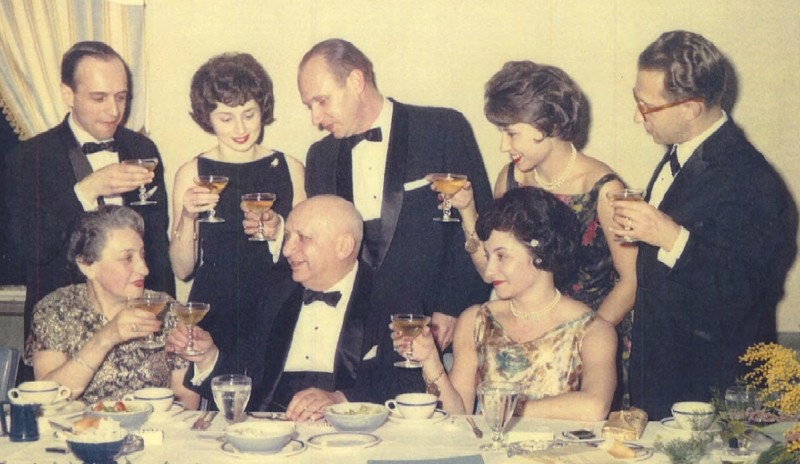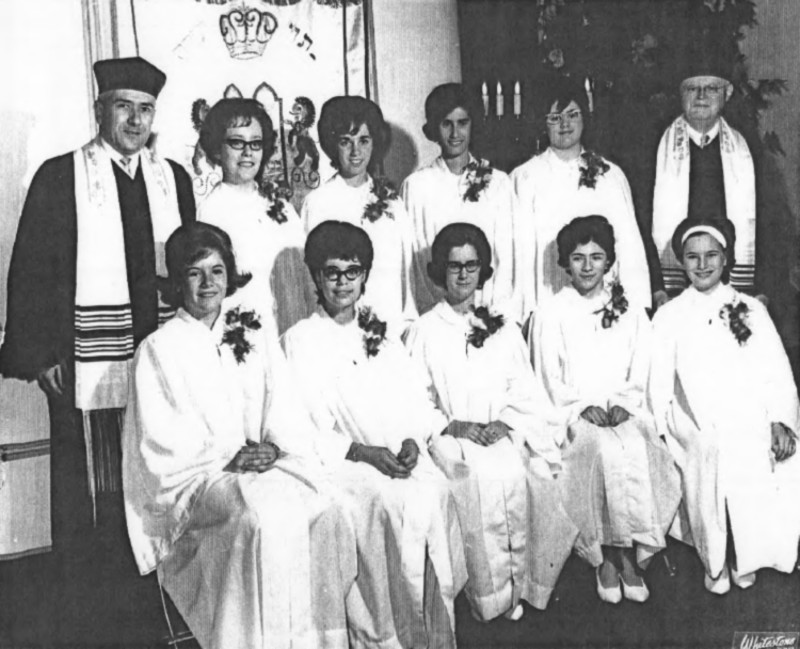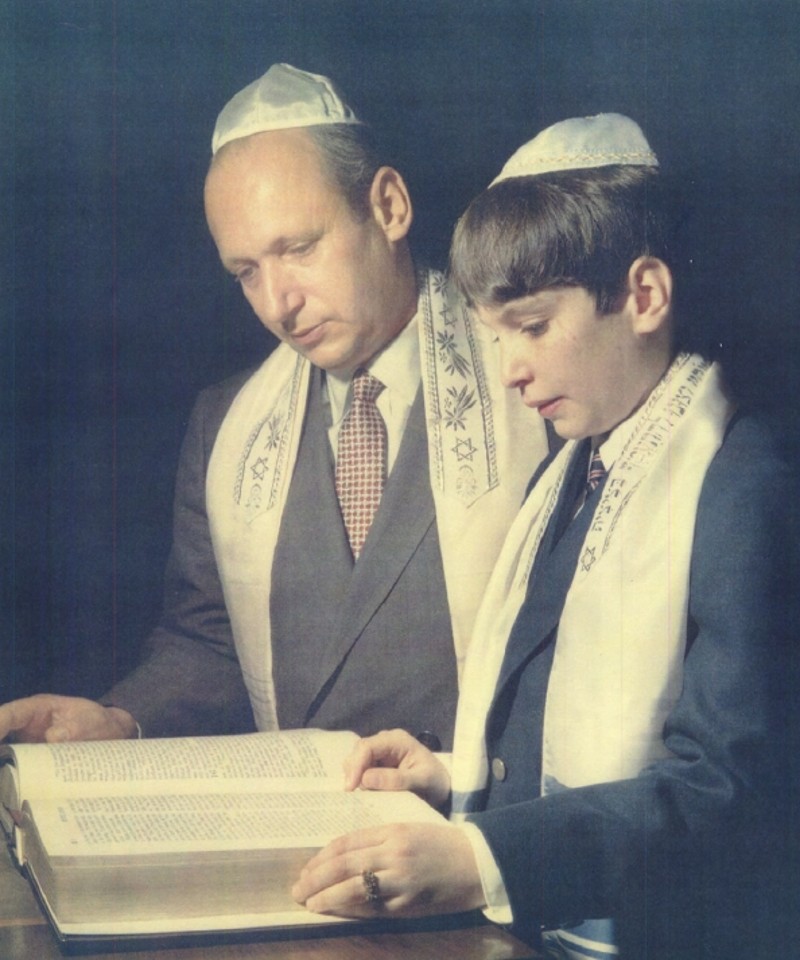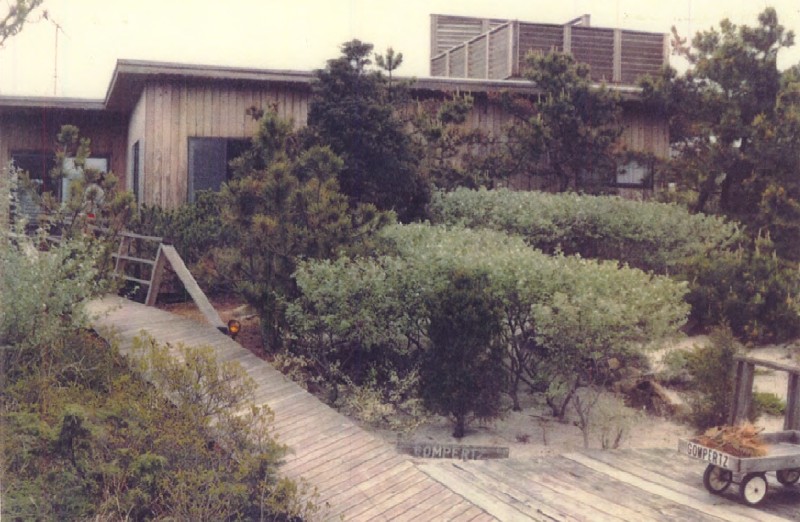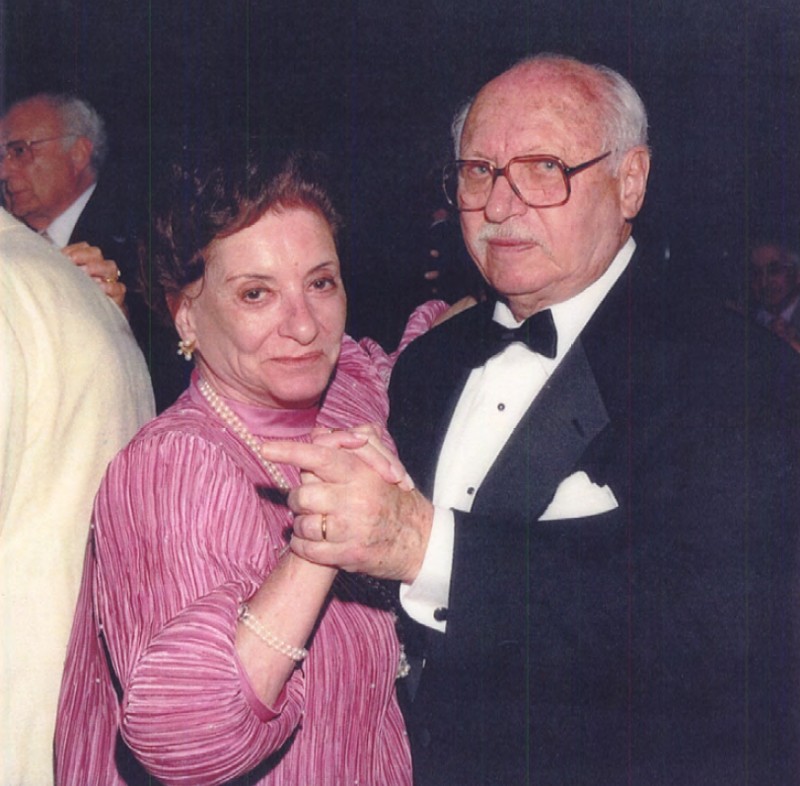Anybody reading these memoirs at this time will realize that our family did, indeed, have a history to be proud of. But, understandably, I prefer to forget my German heritage and have good reason to hate anybody and everybody German, with very few exceptions. MY LIFE STORYWith Special Emphasis on My Childhood in Nazi Germany: A Warning to Present and Future Generations The police arrested me on November 10, 1938, the morning following Kristallnacht when most of the synagogues were burned and Jewish-owned Stores and businesses throughout Germany had been viciously smashed or destroyed. Along with other Jewish men in my neighborhood, I was taken to the police Station nearby and locked up. (I learned later that my father also had been arrested and jailed that day in Gelsenkirchen, our family home.) When this incident took place, I was boarding with a family named Lewin and attending the vocational College for the textile industry in Cottbus, Germany, about 35 miles east of Berlin. Adolf Hitler had launched his anti-Semitic campaign after becoming chancellor in January, 1933, and by this time, in 1938, Jews in Germany had been excluded from most professions; they were required to carry identity cards, and were forced to include in their names "Israel" or "Sara" to indicate they were Jews. But despite these measures, the Nazi persecution campaign was paralyzed because certain German ministries were expressing doubts and demanding clarifications from the government. On the other hand, radicals were calling for more drastic action against the Jews.
After being freed, I returned to the Lewin house and spent the night there, then took a train back to Gelsenkirchen because, as a Jew, I would not be permitted to continue school. From the train window as we proceeded through the towns I was shocked and frightened as I saw the smashed store windows and the burned remains of synagogues. When I arrived home, my father was still in jail and I was shocked even further when I saw that our family store had been smashed. I learned that the Inventory of furs had been thrown into the street and that my brother Fritz was humiliated by a jeering crowd when he swept up the broken Window glass from the sidewalk. After spending a full week in jail, my father was released to face the harsh fact that the government would no longer permit him to operate the business which had been established by his father in 1889. He was obliged to turn over the business to his master furrier, a gentile. Father was permitted to liquidate his inventory for some small amount of cash - and this was the sad end of a 50-year old family enterprise. Further, I have a copy of a Gompertz family tree which goes back to Alexander Gompertz, who was born in 1765 in Issum and died in Geldern in 1828. He was the grandfather of my great grandfather, Gumpel Gompertz, who was born in Uerdingen (outside Krefeld) in 1820. He and his wife, Jetta Sternfeld/Gompertz, born in Goch in 1829, had 9 children (8 sons and one daughter) of which my Grandfather Albert was the oldest. Two of my grandfather's brothers and their wives, Max Gompertz and Ilse, and Gottfried Gompertz and Rosalie, were deported and killed by the Germans in 1942 in the extermination camp in Minsk. In addition to my father's two uncles and their wives, seven out of 24 of my father's first cousins were killed by the Germans. Ernst and Edith Schaffrath (he was the son of Tante Malchen) were exterminated in Izbica in 1942 at the ages of 41 and 39. Alfred Lorant, son-in-law of Tante Malchen, was killed after being imprisoned in Dachau in 1938. Ernst Bernheim and wife Henriette, daughter of Max Gompertz, were exterminated in Auschwitz in 1942, and Walter Sternfeld's wife Klara, also a daughter of Max Gompertz, were exterminated in Mauthausen in 1942. Also in my possession is an old Menorah which has been handed down from generation to generation and has been in the Gompertz family for over 450 years. Here I want to take notice of my mother's history. Her father, Isidor Isaacksohn (in later years changed to Isacson) was born in Libau, Latvia (but Russiat at the time) on September 15, 1875, and he married Flora Masur. She was born in Lissau-Posen, part of Russia at the time, on the 7th of December, 1876. They moved to Rotterdam, Holland, where my mother was born on December 20, 1900. A few years later they moved to Gelsenkirchen, Germany, where Grandfather Isacson started a substantial fish wholesale and distributing business. Isidor and Flora had five more children (altogether three sons and three daughters). Both of my mother's parents were deported from Holland (they moved back there in 1936) and died in the German extermination camp called Sobibor on May 28, 1943. Anybody reading these memoirs at this time will realize that our family did, indeed, have a history to be proud of. But, understandably, I prefer to forget my German heritage and have good reason to hate anybody and everybody German, with very few exceptions. HISTORY OF THE GOMPERTZ FAMILY
MY MOTHER'S HISTORY: THE ISACSONS
"It happened in the year 1900 on the 20th of December, that in Holland, specifically Rotterdam, the Harbor town, a girl with brown eyes was born. The parents had counted on a birth (boy), but everybody came to celebrate and feast: the grandparents, uncles and aunts, as was the custom in Holland. Everybody agreed the child would be bright, because of her eyes and kindliness. Father Isidore (Isaak)* was pleased, and mother Flora was happy, and they named the child Betty — and that they all celebrated about. *Note: Mother's father, Isidore, was born in Libau (Russia at that time), one of six children. Her mother Flora's maiden name was Mazur and she was one of 12 children born in Lissau, Russia. They and many of their family settled in Rotterdam, where Betty was born. Both Isidore and Flora were killed May 28, 1943, at Sobibor, an extermination camp near Auschwitz.
When Albert Gompertz married Sophie Rubens and moved there in 1889, Gelsenkirchen was already a substantial city flourishing on the mining of coal and iron. My father received his education in the state-operated Jewish Elementary School and the Gymnasium High School, both in Gelsenkirchen, and his Apprenticeship was served in Krefeld and Düsseldorf.
Betty and Leo Gompertz with Albert, Rolf and Fred in Gelsenkirchen 1930LEO GOMPERTZ: A STRONG ACTIVISTFather was a man of strong convictions and high ideals and was taught by his mother as well as his grandparents what it meant to be a Jew. He became a regular and active supporter of Jewish causes. Almost immediately after joining his father's business, while in his early twenties, he took over the chairmanship in Gelsenkirchen of the Jewish Youth Organization, which was part of the Neutral Jewish Youth Organization headquarter in Berlin. In Gelsenkirchen, because there were many large businesses owned by Jews, there was a sizeable number of non-native Jewish employees of both sexes living there. A relationship between these "outside" employees and the native-born Jews of the city hardly existed and was not really looked for. My father's first goal as chairman was to establish a closer bond between these two groups. The introduction of organized activities on Friday evenings (Shabbat) and a Passover Seder proved successful, even though the academic segment of our Jewish citizenry (doctors, lawyers, etc.) were at first reluctant to participate. The preconceived prejudice against the employees disappeared or at least diminished when my father's Gelsenkirchen JYO joined with the youth Organization in Essen, a neighboring larger city, to found the Rhineland/Westphalia and branch of the JYO. The new branch undertook travels and tours for members and successfully demonstrated that the youth of both sexes could work together. Lectures and discussion groups drew Jewish leaders to meetings of my father's Organization and the membership grew significantly both locally and regionally. However, the JYO, because of its politically neutral position, did not have a unified voice until it was recognized as a full member of the Jewish Congregation. It then was able to act positively and independently and further its cause and belief that youth must manage itself.
1925: Dedication of RJF (National Organization of Jewish Soldiers) In Cologne (Köln) in Memory of 12.000 Jewish Soldiers killed in the First World War while serving in the German Army
Jewish Cemetery in Cologne-Bocklemünd todayNEW CHALLENGES FOR JEWSAfter the war, my father's work for the JYO earned him a Position on the board of the Jewish Congregation. New challenges arose for Jews in Germany, but unfortunately many Jews closed their eyes to the problem or did not want to face the true facts. This led to dissention among their own number, particularly when it came to speaking out and insisting on one's rights to his Jewish orientation. In the summer of 1920, an anti-Jewish group called the German people Organization published in their Düsseldorf newspaper, THE TRUTH, a call for a mass demonstration in Gelsenkirchen. They sent their members and urged others to attend. Ironically, their meeting took place in the Protestant Community Center where, many years prior, my father's Jewish Youth Organization had held their gatherings. The board of the Central Organizations for Jews, headquartered in Essen, selected a group of five representatives (of which my father was one) to attend the meeting. Since, as a businessman from Gelsenkirchen, father was especially familiar with the people attending, it was his Job to observe and take notes particularly relative to the industrialists who came. To his unpleasant surprise, and later to the detriment of his business, he discovered that in addition to other industrialists, the Director of Commerce and many lawyers and doctors were in attendance. When the leader of the meeting (with whom my father had had previous confrontations) noticed my father in attendance, he sent a young man to father's seat to demand that father leave the meeting hall. My father responded that with the purchase of his ticket of admission he had the right to remain until the meeting was declared a membership meeting and not open to the public. The leader then declared the meeting was for members only and father left the hall without Incident. After he left, however, many of father's non-Jewish friends did not agree with the presiding officer's decision and a general fight and brawl broke out. Since my father was the best known among the Jews present at the meeting, the Organization filed charges against "Leo Gompertz and companions" for breach of the peace and "bodily harm." During the trial, father recognized many of his former schoolmates as witnesses for the anti-Jewish Organization. The charges were finally dismissed both by the judicial Office in Gelsenkirchen and the regional office in Essen. JEWISH INDUSTRIALISTS AND DEPARTMENT STORE OWNERS IGNORE WARNING SIGNALSMy father later recalled that these first confrontations with the forerunners of Hitler's criminals were mostly ignored by his Jewish contemporaries. In a letter on this subject in 1965 father wrote, "The Jewish capitalists were of the opinion that these incidents should be minimized and ignored to avoid direct confrontations and not give new material to these thugs and opponents. They were satisfied to issue memorandums and leaflets which they distributed through the Democratic and Social Democratic parties, but these efforts had little effect. Even a meeting organlzed by my father and supported by many organizations and their offidals, held in the large hall of City Hall in Gelsenkirchen, did not find the necessary attention. However, more than 1,500 gentiles did participate and Hastened to important Speakers from Berlin and other parts of Germany, all of whom were opposed to the takeover of the government by Hitler and his hordes. At this meeting, my father suggested that the Jews drive through the towns and villages on trucks to protest the government oppression, but the idea was considered a confrontation and was voted down. This type of division among the Jews on what action could be taken was to continue until January 31, 1933, the day Hitler became Chancellor. On that day, many opponents of protest had their eyes opened when the first "boycott groups" (calling for the boycott of specific Jewish businesses) were posted in front of my father's store entrance. His business was one of those listed. The next wakeup call came with the government announcement that on April 1, 1933, all businesses owned by Jews had to close for the day. Almost all provindal representatives of the Central Organization of Jews traveled to Berlin to a secret meeting which took place under tight security in the headquarters of the Central Verein. Several Organization members, including my father, from the provinces of Rheinland and Westfalen, attended. They took the night train to Berlin on March 28. During the main meeting, discussions centered on what action should or could be taken in response to the boycott. A motion was made to approach the Reichsministerium and ask that all Jews be granted passports to leave the country. The motion was supported by my father and his group, and it seemed that the proposal would be approved. A recess was called to consult with the Chief Rabbi of Germany who was also head of all German Jewish organizations. Dr. Leo Baeck declared himself Willing to go to the Ministry of the Interior and bring the passport Suggestion to Minister Hermann Göring. (In 1933 such a move was still possible.) Dr. Baeck deferred the final decision to the vote of the meeting, and after Dr. Baeck left, the discussion continued. However, the wealthiest and most successful in the Organization finally vetoed to idea and called those who had proposed it in the first place including my father), cringers, ass kissers and deserters. Max Blank, a member of my father's delegation, then made a motion to close their businesses not just for one day, but to keep the stores closed for at least one week. That idea was also voted down. The chairman closed this "memorable" meeting with a personal Statement: "Once April 1st has fortunately passed us, I will go to the Synagogue and say my thanks in prayer."
In the years following, my father's business was constantly boycotted and singled out for harassment by the Stormtroopers (SA). Considering these abuses, the question might be asked why at this point he did not take his family and leave Germany. The reason was that he agreed with the Position of the Central Jewish Organization which felt that to emigrate meant to desert other Jews — in effect abandon the entire Jewish Population. This same Position was preached in the German synagogues. In 1919, he helped form the German Jewish Front Veterans Organization and served as President of the Rhein/Westfalen district. This Organization was established to defend the Jews against the accusations by forerunners of the Nazi party that Jews did not to their part in defending the "Fatherland." During the summer of 1937, a major event occurred which confirmed my father's suspicions of intensifying anti-Semitism within the government. Industrialist Kierdorf, the first and most important financial supporter of Hitler, died, and on the day of his funeral Hitler and all the other prominent leaders of the Nazi movement, such as Göring and Himmler along with hordes of Stormtroopers, marched through Gelsenkirchen and threatened to destroy the center of town because it was dominated by Jewish-owned businesses. On October 28, 1938, without warning, all Jews with Polish citizenship or who were born in Poland were suddenly arrested and deported — even while some of their children were still in school. Thereupon my father summoned his friends to the Office of the Jewish Congregation to accept into their homes the suddenly abandoned children. Since my father had us three sons at the time, he took one child into our home. The boy's name was Grünspan, but not related to the Grynszpan in Paris who triggered Kristallnacht by shooting Vom Rath at the German Embassy. (Grynszpan's parents had been deported to Poland on October 28, and on November 7, Grynspahn, who lived in Paris at the time, went to the German Embassy to shoot the German Ambassador. The ambassador was not in Paris at the time, therefore he shot the next in command, Vom Rath.) A thank-you note to my father was the last sign of life from the abandoned boy's parents. LAST WARNING BEFORE THE FINAL SOLUTIONSome years later, my father wrote the following account of his personal experiences on Kristallnacht: I was prepared for Kristallnacht after the murder at the Paris embassy. Before I left my business on November 9, I organized my desk and made the necessary arrangements for my wife. Kristalnacht supposedly was caused by the "boiling soul of the German people," but in reality it was organized by Göbbels and Göring and carried out by the Stormtroopers in their long black rubber coats and boots. They carried long crowbars and systematically smashed the show Windows of all Jewish-owned businesses, including the nine large display Windows of my store. I remained in my apartment above the store waiting to be taken into "protective" custody. I received a telephone call advising me that our synagogue was on fire. From my upstairs window I could see the flames and the fire trucks that came only to protect the neighboring buildings; they did nothing to stop the fire in the synagogue. Then came the moment: a Stormtrooper officer came to the apartment with three of his men. They first searched for hidden weapons and took me away. My two boys were asleep and I said goodbye to my brave wife. (My oldest son Albert was away at school in Cottbus, east of Berlin, and I did not know his fate. I was taken to the prison at police headquarters. As I left my building I saw the broken Windows with the valuable merchandise in the street. I was placed in a cell along with thirteen other men, some who had been beaten bloody. We shared the space and made the best of our circumstances. The police stood guard that night with rifles at their sides but they were not allowed to contain the Stormtroopers who kept on destroying and rioting. The commanding police commissioner greeted us with words to the effect: Today you, tomorrow us. What those words meant and held for the future neither we nor he could foresee. Around midnight a representative of the duty appeared and requested Mr. Ewald Elsbach and me to sign a document authorizing the tearing down of the burned out synagogue and Community center. We refused to sign the document giving as our reason that only the President of the Congregation and our Rabbi Dr. Siegfried Galliner had the right to give this authorization. (Dr. Galliner at the time was in the house of the President of the Zionist Party in Gelsenkirchen. None of the Jewish residents in this house were arrested.) At noon on the tenth of November, Herr Honroth, who several years earlier had been a teacher of my son Albert, lead a gang of high school students into my store and completely destroyed the interior and anything that had not been destroyed the previous night. My Jewish employees were made to clean up and remove the glass fragments with their bare hands. My second son Fritz (Fred), who was 14 years old at the time and had worked as an apprentice in my factory, was also commanded to help in the cleanup. At this time I must add that the greatest praise belongs to our Jewish women who during this period, without shedding a tear, managed to instill respect into these thugs who had beaten their men bloody. With their spirits Intact our women did all they could to free their men as soon as possible. Between the 15th and 18th of November, 1938, all Jews arrested in Gelsenkirchen were released without being sent to a concentration camp, but, in many cases elsewhere, Jewish men were sent to concentration camps for weeks or months. There they were beaten and starved and many died or came back crippled. I received an order to sell my house to an appointed "interested party' and never to reopen my business. Further, I was ordered to emigrate as soon as possible. PREPARING TO EMIGRATEWhen father was ordered to liquidate his business and abandon ownership of the house without any reimbursement, he was permitted to Charge some nominal amount of money for his Inventory, but not anywhere near its value — it was practically pennies. When this was done he began to pack our personal belongings in storage Containers which hopefully he would be able to move to America, but he did not yet have an exit Visa from Germany or an entrance visa to any other country. The boxes were placed in a large wagon for transport but it never made it out of Europe. (We learned later that It was destroyed or plundered in the Invasion of Belgium, so we never saw any of our personal things again.) Prior to this, around 1936, father had applied for a visa to enter the United States where my mother's father, Isidore Isacson, had a second cousin, Anita Loew, a singing teacher, who lived in New York. (At one time she sang at the La Scala Opera in Milan, Italy.) She came twice to Germany to see if she could help us. We needed an affidavit of support before we could even apply to the American embassy for a visa. Unfortunately, she did not have that much money so she needed time to find others to assist her. Eventually, she was able to meet the financial requirements and it was through her that we were able to apply for the entry visa. While he was liquidating his business, father managed to handle all the necessary paperwork with the police and get temporary visas for my brother Fritz and me to leave Germany and go to a refugee camp which the Dutch had set up in Holland. My youngest brother Rolf, who was ten years old at the time, had already been smuggled across the border by a non-Jewish Dutchman who entered Holland for a Visit and took Rolf along. So Rolf was out of the country and was Iiving with his grandparents. But even though my mother's parents lived in Holland, she didn't have an entrance visa to Holland because the Dutch, too, were very restrictive as they were afraid they would have more people Coming in than they could handle. Also at that time my father was still closing out his business, so neither of our parents could leave with us.
Occasionally, those like us who had relatives living in Holland, would receive day passes to Visit them. But it wasn't until August, 1939, when my mother and we three boys finally received our entry visas to the U. S. that we were allowed not only to Visit but to stay with our grandparents, which we did until the day of departure, September 3rd. We had received the visas because mother, being born in Holland, was under the Dutch quota and we boys were under age 18. My father, though, had not obtained his Visa since he came under the more restrictive German quota, so he was unable to leave with us. However, he was permitted to stay with us the last week, but then had to return to the camp. (He was fortunate to receive the Visa in January of 1940, just a few months before the German hordes invaded the Lowlands, including Holland.)
Photograph of the last time the Isacson's and Gompertz and all their children met in Velsen, Holland. Two days before Albert, Fritz Rolf and their mother Betty sailed for America. It was also the day the Germans invaded Poland. From the left to right: standing Fella Goldschmidt, next Rita and Ernst Heymanson, then Betty, Albert and Leo Gompertz, Sophie and Max (Marcel) Isacson, Hilde and Herbert Isacson, Bep Weynshenk with her fiancee (at that time) Lutz Isacson. Seated on left our grandmother Flora Isacson, Fritz Gompertz (in center) and seated on right grandfather Isidor Isacson, seated in front Ellen Heymanson and Rolf Gompertz.
The M.S. Statendam III in Rotterdam 1939. In the first days of May 1940 while laid up at Rotterdam, the Statendam III was bombed and destroyed by the German Luftwaffe.SAILING TO AMERICAOur family spent the last day together, September 2nd, at Uncle Herbert's house in Velsen. Ironically, this was the same day that England declared war on Germany. The next day my father brought the family to the dock in Rotterdam where we boarded the M. S. Statendam for our long-awaited journey to America. At some point during our farewell excitement and before returning to the refugee camp, father secretly gave two letters to the ship's Purser to be delivered to my mother at the breakfast table the following morning. Here are portions of my father's thoughtful and caring letters which the Purser gave to my mother as requested. My Beloved Betty, Good morning ... I wish you a hearty appetite at the first breakfast on the high seas. In my spirit I sit with you at your table and notice how you, dear Betty, proudly look at your boys, and the few low passengers try to determine whether you are the nursemaid or sister. But I hope that very quickly they will notice your motherly concern and realize the true facts. In the last months and weeks so much remained unspoken between us, but I truly feel and know that we nevertheless understood each other. I therefore hope that in my thoughts I will always be with you to offer my advice and Council whenever you feel the need for such — so that you will always be able to Visualize how I would feel about matters which you will have to decide on your own. Yes, my dear Betty, after all I can no longer call you "dear child" — or maybe yes??? After almost 19 years of marriage, you begin this great voyage across the ocean with the boys, but without me because this terrible criminal In Germany forced us to this decision. What I feel this minute I know I do not have to put into words and do not have to put on paper. You know that I always wanted to take care of the needs of my family, since the wellbeing of my family was in the end more important than outward successes. To know you are all alone at this moment with the worMes about your future and that of our sons, even though I am alive, seems like a bad dream to me. I believe it is for our best that we were forced into this Situation, because to think otherwise, at least for me, would make the Situation completely unbearable. But the thought that we will see each other again soon lets me recondle the Situation. Therefore I Just Visualize you on a very great trip with our sons to Visit a dear relative who will assist you with help and support and who will try to do what really is my duty... We live for our children, the living proof of our love, and I hope, no, I know, that in all my love for you I have given my love to them and raised them in the best way possible that a man and father can do... So, my beloved Betty, may the boys be your Gold Reserve; more valuable than money. May your great motherlove never be disappointed and the faith in our boys be positively confirmed and strengthened from day to day and make you happy. If that happens, then my love and all my labors for you will be a crowning glory. Now, beloved Betty, continue to enjoy the breakfast. And if you with your good heart read these words with love, without being sentimental and in the same spirit in which they were written by me, even if separated by the distance, through love we will remain two fortunate and closely connected people... The guns roar and thunder. You flee from evil, and may you find good in your new chosen homeland. Once again give my kisses to the boys and give them the enclosed letter ... Good luck and happy crossing! In unwavering love, Your faithful Leo Following is part of his letter to his sons: Dear Albert, Fritz and Rolf, Now you are sitting, my dear boys, with our Mutti at the nicely set breakfast table, hopefully in the best condition partaking of the first breakfast on board the M. S. Statendam on your way across the ocean into your new homeland, the big United States of America. The ocean surrounds you, the sound of the waves fills your ears, and you will become aware of the tremendous size of our world. On other occasions I have put into poetic verses whatever I had to say, and how often, I believe 20 times, I expressed in verse my feelings and your thoughts about your dear mother. I hope, no, I know, that you recited the poems not only with your Ups but from the heart... You dear Albert, the eldest, are co-responsible for the well-being of your brothers. To help them must always be your endeavor. No bad word, and no bad deeds can come between you. All three of you must work together and strive for your mother and therewith for your future. In every case, whatever you plan to do, ask yourself what does your mother think about it? Your health is your valuable asset, therefore treat it as such. Follow the wise counsel of your mother who, like me, wants only the best for you. I know that you, dear Fritz, are Industrious, and you, my little Rolf, are a good learner. Therefore I expect that all of you will use your talents to the fullest because in your new homeland you can prove what your Potentials are... Show the world your love and devotion to your mother through your actions. Make her proud by your behavior and actions and by your successes. Never be ashamed of your origin by birth, because only those who respect themselves earn the respect and attention of others. Let your steps in your new land be steadfast and sure. Stay healthy — and my love also from the distance, - Your father These letters, obviously, are heartfelt expressions of the deep and abiding love my father had for his family, and particularly for his wife.
While we were on this "great voyage across the ocean" as my father called it in his letter, I had time to reflect on my own life of 18 years... GROWING UP IN GELSENKIRCHEN
While my upbringing was strict, I was raised with all the love and devotion my parents could heap on their first-born. Even in those pleasant days, though, I do not remember ever playing or associating with any gentile children because all my parents friends were Jewish. In April of 1928, I started school at the Jewish Elementary School (Jüdische Volksschule) in Gelsenkirchen; there was no nursery school in those days. Even before Hitler, and I believe still today, a percentage of one's taxes were distributed to the religious Institution of your denomination. That was how schools and churches (synagogues, too, before 1938) were mostly financed. The elementary schools for all denominations had eight grades. After four grades, students had to decide if they wanted to go on to a higher education, which led to the University. There were three choices of schools at this level: for boys there were RealGymnasium, based on Latin, and Gymnasium, based on Greek. For the girls the school was called the Lyceum. I finished my fourth grade in 1932. In addition to the basic three R's in those first four years, we were taught History and Geography, and also received Jewish education — not only in school but at the Rabbi's house, and we also attended Jewish Services at the Synagogue on Friday evening and Saturday mornings. The name of my teacher was Mr. Katz and the Rabbi was Dr. Galliner. Again, because of the segregated education System, we had no contact with Gentile children. Starting in 1928 (and probably prior to that) and then escalating every year, the anti-Jewish sentiment in Germany grew. It was spurred by the National Socialist party (Nazi's) but was supported by a large segment of the German population. By 1932, most children from age six up were urged (and forced) to join the Hitler Youth Movement, which gave members pre-military training and also required them to report any comments made in their homes that were unfavorable to the Nazi's. While I couldn't associate with my Gentile classmates, I had many Jewish friends. After school we rode bikes, played chess, ping pong and other games. And by this time, 1932, the Jewish War Veterans (my father was the local Commander) had formed a Jewish Youth Group called the Schild (the Shield) and we met at least once a week for gymnastic exercises. On weekends we met at a makeshift outdoor field for soccer and other field exercises such as sprinting, high jump, long jump and the like.
Gymnastic Group of RJF Schild Gelsenkirchen in 1934. Third row from top, fifth from right: Albert Gompertz. In center Ruth Stamm and Leo GompertzNaturally, the progressively growing anti-Jewish sentiment influenced and depressed me and the other Jewish children, particularly because we had to be constantly on the alert to avoid contact with any of the Hitler Youth and other hoods who might beat us up. In the spring of 1932 I was admitted to the Citywide Realgymnasium on Adolf Hitler Strasse in Gelsenkirchen. I started in the grade called Sexta, and Latin was our basic language next to German, The following years I entered Quinta, and then Quarta, at which time French was added to our curriculum. After Quarta came Untertertia, and in the spring of 1936 I entered Obertertia with English as a third foreign language. However, in September of that year, I was dismissed along with all other Jewish students (there were not too many any more) because of new edicts issued by the governing Nazi party. I did receive passing grades in all subjects except in Religion (which we received at our Rabbi's house), and in mathematics I was graded "good," which meant above average.
Albert and his bicycle: on left "showing off", center and right: packed and leaving Haus Berta
I also worked in the office and learned everything there was to know about creating the finest worsted fabrics. In the evenings at the textile College, in addition to all the other subjects I took, I also learned how to design, and actually did handweaving on Jacquard looms. While I was treated nicely by most of my co-workers (after all I was the 14-year old kid on the block) I had no social contacts outside the factory. But then I must add, I had no social contact with the Jewish owners or any other Jewish Citizens of Aachen with some rare exceptions. Once one of my bosses had me for dinner at his house. But, naturally, I could not expect much attention because I was only an apprentice in a textile mill. However, I did have as friends two Jewish boys who were also apprentices at two other mills in Aachen. Once in a while we went together to the movies or we played board games in my room. I remember one occasion (in 1937) when we stayed up all night in my room listening to the radio waiting for the world championship boxing match between the German Max Schmeling and the American Joe Louis. Needless to say, we cheered when the American beat Schmeling. My father made me keep a detailed accounting book showing my income and every penny I spent (like a cup of coffee for 5 Pfennig, roughly 5 cents!), and I had to present it to him on my Visits to Gelsenkirchen when I went there by train or bicycle. Occasionally I also went by bicycle to Krefeld where I had all my great aunts and uncles and many second cousins. I remember once bicycling to Arnheem in Holland to meet one of my mother's cousins. Aachen is located at the southwest corner of Germany where Germany meets Holland and Belgium. I spent two years in Aachen, until September 20, 1938, and I received a very fine letter of recommendation from Herz & Hayman and also a very good report card from the evening school of the Textile College. I left the apprenticeship at that time because I had been accepted for a regular course in textile engineering at the Cottbus Textile College located 30 miles east of Berlin. The acceptance from this College was dated September 14, 1938 for a course in textile design with the semester beginning October 13, 1938. Little did we know at that time what would happen less than one month later on November 9th.
ARRIVING IN AMERICAOur crossing from Holland to Hoboken, New Jersey, aboard the Statendam, was an exciting one for all of us. We sailed on September 3, 1939, the day after England declared war on Germany, and after one day out of port our ship picked up survivors of a British naval ship which had been sunk by a German U-Boat. Nonetheless, we were absorbed with looking to the future and so glad to be underway that the war didn't sink into our minds. Much of the time I was seasick but I remember enjoying lying in a deck chair taking the fresh air. We debarked in Hoboken on the second day of Rosh Hashanah, which I believe was the 12th of September, 1939. We were met at the Holland America Line dock in Hoboken by Anita Loew, my mother's cousin, who with the help of some of her family and friends had made our trip possible. She provided us with the necessary affidavit of support, which was necessary to receive an entry visa and the green card to live in the United Sates. It never occurred to us or any of the other immigrants of that time to ask for immediate public or private assistance, which is taken for granted by more recent immigrants — both legal and illegal. But the U. S. immigration laws were strictly enforced in those days. Naturally, all of us were so happy to have arrived in this wonderful country where we Immediately felt what it meant to be a free person. In that era, if any of the immigrants would have needed support, the Providers of the affidavits would have been held responsible for their well-being. Cousin Anita, who lived across from Carnegie Hall, took us to the room she had rented for us in Manhattan at 2345 Broadway (southwest corner of 86th Street). The room was small for the four of us, but it was adequate. It had a cooking area and a bathroom and there were couches which converted into beds at night. Anita had paid the first week's rent. When we finally left Germany we were only allowed to take the equivalent of $25.00 each. I do not remember if my mother received any cash from her parents before leaving Holland, but in any case it would not have been a large sum, so we had to find work immediately to support ourselves. On our first evening in New York, cousin Anita took us to dinner at a good family restaurant, Ellman's, at 89th Street and Broadway. My mother managed to find work right away sewing evening bags at home (although she really never had done such work) and was paid by the piece. So as not to waste time, on the day after our arrival I went out to look for work and was told to go to the Hias Jewish Agency for help. Fortunately, even before I could talk with an interviewer there, I was hired by a man who owned a small delicatessen on Columbus Avenue at 78th Street. My knowledge of English was still very limited but I learned the language rapidly. At the delicatessen I was an all-around delivery boy, stock boy and cleaning clerk. My work day was 12 hours long and I worked six days a week, for which I received $6,00 plus some tips. Everything I earned went towards our support and I was happy to be of help. (Both of my brothers were too young to work and were registered in public schools.) With my schedule, I really had nothing in common with all the other carefree American teenagers, but I was happy to be in the USA! After about three weeks at the delicatessen, I went back to the Hias Agency, this time for a real interview, and found a job at a millinery supply house as a stock boy for $12.00 per week with regulär working hours. Aside from people I met at work I still had very little social contact; I played some ping pong at a parlor on Broadway at 78th Street, but basically we were busy supporting ourselves. Naturally, we followed events in Europe with trepidation, and even more so as my father still could not get his visa to join us. Finally, in January of 1940, he managed to leave Holland on another ship of the Holland America Line. This was only two or three months before the Germans over-ran the Lowlands (Holland and Belgium) and invaded France. The reunion of our family, of course, was joyful except for the fact that my mother's family as well as my father's sister and her daughter were trapped in Holland.
We were lucky and grateful to have made it safely to America and to have found work so quickly.
ADJUSTING TO AMERICAN LIFE
In the spring of 1940, Erwin introduced me to a group of young people who had formed what they called the "Young Friends Group," which met at a YMHA at 110th Street near Central Park West (north of Central Park), and we socialized there on Sunday mornings and early afternoon. The group was a mixture of male and female immigrants and some "Americans," mostly females. A few years later several marriages took place within this group. (I remember distinctly that on December 7, 1941, that fateful Sunday morning, while we were having our regular get-together we heard the news of Pearl Harbor.)
From right to left: Nettie, my friend in Allentown 1942, Nettie in August 1944 sent me the following New Years greeting, while stationed in France: "Our hopes are for victory in 1945, that's the goal for witch we strive. Now may I wish you a Happy New Year and add a prayer for your safety Dear! Nettie". My New York Friend in 1942: "To Al, in remembrance of nice times spent together, yours, Claire".BECOMING AN AMERICAN SOLDIER
Since I was in good physical shape and certainly had not been spoiled in my childhood or during my life up to this point, the basic training I received during those eight weeks at Camp Lee succeeded in making a good soldier out of me. I acclimatized to the tough life and the demands made by my sergeants and officers, and for the first time, because I was in close contact and living with American-born men from all walks of life, I felt like a real American. After four weeks I received my first day pass and was able to Visit the Jewish Community Center in Richmond, VA. The eight weeks passed quickly due to the strenuous demands made upon on all of us recruits. As soon as my basic training as a private was completed, I was promoted to a T/5 (Technician Fifth Grade) and classified an Interpreter because of my knowledge of the German language. On February 25, 1942, eight other trainees and I were given travel Orders to report for duty with the 441st Prisoner of War Processing Company in Camp Swift, Texas. I was even placed in Charge of our group of nine men and we traveled by train to Texas by way of New Orleans. The interesting part of this trip was for me to see for the first time other states and parts of the United States. (For example I did not realize how unusual it was to spend a day in New Orleans where it actually snowed.) Also I became more American by meeting and associating with other Americans from all over the country, while many of my fellow immigrants (some to this day) thought that New York was the center and most important part of the U.S.A.
In Fort Custer (near Battie Creek, Michigan) we were trained and organized to process and Interrogate future German prisoners of war. This time the army had planned well, since the first German prisoners were taken in Africa late in 1943 and transferred to prisoner of war camps in Texas, Louisiana and New Mexico. MY NATURALISATION AS AN AMERICAN CITIZENSince we were destined to go overseas eventually, it was a rule (or law) that all U. S. soldiers who were not Citizens would be naturalized (normally you had to reside in the U.S. for five years in order to be eligible for citizenship). Therefore, on May 24, 1943, I was sworn in and received my Certificate of Naturalization from the Circuit Court of Calhoun County in Battie Creek, Michigan. On June 5, I received a copy of a letter from the Naturalization Officer of Fort Custer to the Commanding Officer of the 441st POW Company, informing me that I was a U.S. Citizen but would receive the document only upon my honorable discharge.
It was a very hot summer in Texas and we had to be careful not to become dehydrated or suffer sunstroke. After awhile we received weekend passes or three-day passes and I used mine to go to Dallas either by bus or hitchhiking. The fastest way was to get a lift from a pilot from a nearby Air Force base because they drove like they were flying. But on my first trip on a Friday afternoon I received a lift from a traveling salesman who turned out to be Jewish and who took me home for a Shabbat dinner. It so happened that he had a daughter (she was six years older than I) whose husband had just left for military duty. So it seemed only natural that on future Visits the father lent us his car and she showed me the sights around Dallas. (I considered this a continuation of basic training!) This young lady worked at Neiman Marcus, the original store in Dallas, so our association caused me to acquire a taste for all sorts of "fashions." Many years later I was reminded of these trips through and around Dallas because they took us past the spot where our future President was assassinated.
Albert with Shirlee at Night Club in Dallas, Texas Continuation of "basic training"At this point, German prisoners were being received in various POW camps in this country and our Company began to practice the interrogation duties we were trained to perform. Naturally, I did not enjoy the fact that these soldiers (Nazi's to me) were treated with kid gloves by the U. S. Army, but being a Citizen now I had to learn to accept this fact. In September of '43, in anticipation of our going overseas in the near future, I received a furlough to Visit my family. I spent the High Holidays in New York and was proud to wear my uniform to the Town Hall to attend Services of the Congregation Habonim, which had been formed by German Jewish immigrants. During this furlough I also visited the factory and showroom of L. F. Gompertz, which my father had started with my brother Fred after Fred graduated from the High School of Needle Trades. I remember my father's pride (especially because I was in uniform) taking me to lunch at the Trader's Restaurant, the hangout of the Fur Trade. At the end of my leave it was a difficult goodbye for my parents and me because they knew I would soon be in Europe with the American forces fighting for the defeat of the Nazi's. After I got back to Camp Hood, our unit was sent to more and more POW camps in Texas, New Mexico (that's how I got to see the Carlsbad Caverns), and Louisiana. Finally, in March of 1944, the 441st was sent to New Jersey for embarkation to England. SAILING FOR OVERSEAS DUTYWe sailed on April 13, and arrived in England without Incident on April 26. The unit was first sent to Brighton, on the east coast of England, where the locals did not believe that we were Americans because, before we arrived, a unit of black soldiers (the troops were not integrated at that time) had been stationed there and they had convinced the residents, especially the female Population, that they were the original Americans. We did not stay there long — just long enough to play a soccer game against English officers, but I think we played too rough for them. From Brighton our unit was sent to Manchester, where a factory was converted into a POW camp. We went about our task, but I especially did not appreciate the fact that we had to stuff sleeping bags with straw for the German officers before their arrival, and that we were to salute the German officers since we were only enlisted men. However, I managed to survive this Insult without a court martial! I received one pass to go to London, where my Uncle Lutz's fiancee lived. She was alone there because after he escaped from Holland on a flotilla of small boats, he was sent to Australia as an enemy alien. Eventually he was allowed to return to England and join the Free Dutch Forces. Upon my arrival in Piccadilly Circle during the blackout (this was still the time when the V2 rockets were Coming into London in from Germany). I just hung on to the soldier in front of me until we somehow found the U.S.O. The next day I met my future aunt (my uncle was engaged to her sister at the time) and then it was time to travel back to duty in Manchester. In reality, our stay in Manchester, while it seemed like a long time, was fairly brief because in just a short while there we were sent to Stonehenge, our embarkation point, to wait for D-Day. We were actually camped across the road from Stonehenge. (Some guys from our unit — not me — might have been responsible for another stone toppling at Stonehenge?) CROSSING THE CHANNEL TO FRANCE
September 1944 near Alencon, France. Our Prisoner of War Processing Co. in action on left German Prisoners - on right awaiting the next batch of Prisoners searched. The interrogation is being done inside the tent - Albert's job.On D-Day Plus 5 it was our turn to board the LT landing craft and make the trip across the channel to France. Luckily for us our troops and our allies had established a solid beachhead by then, so we were able to debark without drawing enemy fire. However, because of the bad weather and possible attacks by the Luftwaffe, our crossing on the LT and landing at the French beach was just as perilous for us as it was for those crossing ahead of us. When we landed at St. Lo, the duty had not been completely liberated but our troops made great advances every day. For the next few days we dug our foxholes near and next to the hedges, and after that we were able to set up our POW camp and get started on our job of Interrogation.
Since our forces advanced continuously, we did not encounter any military action but we moved to various POW camps and did our job, which also included de-lousing and other disagreeable Chores. Eventually, the advance of the American and Allied troops was so swift that our unit was left behind.
As I mentioned earlier, we were equipped only with carbines which were not sufficient for infantry duties. Therefore I, along with other soldiers from all over France, were sent to a seven day intensified infantry training course which included handling the M-1 rifle and hand grenades. (My army records show that I was a rifleman for two months.) At the end of this specialized training we were sent to join our troops fighting the Battle of the Bulge in Belgium (and a large percentage of this group of replacements was killed). I did not realize my good fortune at the time, but the day we were to leave for the front lines, an orderly came out of the headquarters with a list of about six names of soldiers who were needed as Interpreters rather than rifleman. I was on that short list, so instead of being sent to the Battle of the Bulge, I was sent to Versailles outside Paris to await assignment to the Military Government detachment, A-1, which was presently stationed in Paris and eventually scheduled to go into Berlin. (I obviously didn't know how lucky I was because it certainly did not change my lifelong habit of bitching, complaining and criticizing) At this point in time, instead of having to prove myself in the infantry as a soldier in the Battle of the Bulge, the last stand of the Germans, I was now assigned to the Military Government waiting eventually to go on to Berlin. During this waiting period we were training outside of Paris, which gave me the opportunity to visit Uncle Marcel and Sophie in Paris and take them some additional army rations and cigarettes. They were well and extremely happy to be liberated.
After finding Uncle Marcel and Aunt Sophie they showed me around Paris. At right I am posing outside Cafe De La Paix on the left bank.The Allies were making continued good progress: Krefeld had been occupied and Gelsenkirchen would not be far behind. While in Paris I also visited Helmut Hertz, brother of Richard and brother-in-law of my second cousin Gertrud. Helmut also worked for the Military Government in Paris and I gathered that he, too, would probably wind up in Berlin. By April, 1945, we were traveling through Belgium getting closer to our goal. My father, during World War I, must have been in some of the places we passed. And not too far from our route were spots where my parents and my brothers and I spent time at the beach on some of our vacations. RE-ENTERING GERMANY AS AN AMERICAN SOLDIERWhen the Germans capitulated on May 9, 1945, I crossed into Germany. While I was enroute I traveled through Holland, from which I had left to go to the USA in 1939, and it gave me great satisfaction to be at the wheel of an American Army Jeep when I crossed the German border and the Rhine River. It also gave me a satisfied feeling to see some of the once-beautiful towns and villages destroyed and many of the Germans, who all now claimed to have been Social Democrats and innocent of all the injustices they participated in, suffering and miserable. It was a strange coincidence that the road we took to Germany passed Haus Berta, the Jewish Youth Camp my father had helped found. Since I was driving in a convoy I could not stop, but the restaurant on the corner of the road was still there, Neighboring towns like Haltern, Wesel and Münster did not exist anymore — they were just rubble heaps. Before we left Belgium I was pleased to participate in the joyful celebrations of the residents in the city of Namur, and even to dance in the Red Gross Casion Club overlooking the river Meusse. The first place our unit took over as the military government was in Detmold, six miles from the Herrmans-Denkmal (Monument). I still remember the trips our family took to Detmold and I also think I went there by bicycle as a young boy. The hotel we occupied was called Hotel Johannaberg and was where Hitler and his hoods housed Aryan girls who were impregnated by the proper Aryan men. The girls would then give birth to their babies who most likely were sent to Brazil to be raised in the Nazi tradition. (The hotel previously was owned by soap manufacturer Hoffman Stärke and then by the Deutsche Bank.) Officially it was called a Recovery Place for Mothers and was run by Nazi organizations. It was fun for our group to be waited on and have all housework done for us by German women and some men. (The German women, even under the age of 40, did not object to serving Jews, as was forbidden under the Nazi Nurenberg laws.) Fraternization by our troops and the German females was strictly forbidden but was impossible to enforce.
On left my "personal requisioned" car with proper military Government markings. Center: 'Fraternization was not allowed', but who is in charge? My very personal assistant Gisela, who was on duty 24 hours a day. Right: Gisela posing in front of another car of mine ready to leave on "official" business with me.One of my Jobs was to find and provide proper lodging for our officers and troops. This necessitated making Germans vacate homes and Offices, especially those in good condition. We would give the owners very few hours to clear out, which sounds cruel and not a pleasant task for an American, but then I remember what these people have done to the world and to our family in particular and I felt that they deserved even worse treatment than that.
Our group of six officers and six enlisted men was assigned to administer the Zehlendorf District, which included Wannsee and other districts, none of which had been damaged in the Allied air raids. (The story goes that the Air Force knew which areas would be occupied by the Americans.) With Information I had gathered from our German staff in Eisleben, I concentrated on the best buildings to serve as our headquarters. First, we took over the Kaiser Wilhelm Institute, but we were thrown out very quickly by the Headquarters of Military Government for the American Sector. After that I moved our outfit to the former vi IIa of German Commander General von Brauchitsch, and I took over a desk of World War I German Chief of Staff General Moltke for myself. The Russians had plundered most of the furniture and I set a large crew of Germans to work to bring everything in the vi IIa into good shape. But a higher ranking American General decided that he belonged in this lavish building, so once again we were out!
American Military Government for the District Berlin-Zehlendorf-Wannsee September 1945 at our Headquarters the former German Philatelic Museum. From left to right: sitting Lt. Sponholz, Lt. ware, Lt.Col. Horney, Capt. Kasprzyck, Lt. Sweeny, standing Pfc. Mallon, Cpl. Gompertz, Sgt. Mychaluk, Cpl. Reed, Pfc. PittBy now I had learned my lesson, so I found a nice quiet side street with two houses back to back. We used the larger one in front for our officers and the adjoining one in back was taken over by the enlisted men. Incidentally, this smaller house, which I made my "home," had belonged to Admiral Canaris, chief of the German U-boat fleet until he was executed by Hitler shortly before the end of the war. Our Office headquarters was the former Reichspostmuseum (Philately Museum of Germany), a very luxurious building. (In photographs which we took of our staff, the women we hired and employed, for some reason, were much better looking than the fraternization rules suggested, but we did not have to wait for Bill Clinton to show us how to pick our help!)
The German Civilians we hired to work for the American Military Government Zehlendorf. Since I was the official Interpreter it was my job to find "eligible" persons. Seated second from right became my secretary (Today you would call them Interns.)In the meantime, I served not only as Interpreter but also as prosecutor for our small Claims court. I also had the pleasant task of finding proper housing for any officer or branch that needed such. I usually gave the occupants four hours to get out of their homes. The best-known person I evicted was Heinz Rühmann, a popular pre-war German movie star.
In late September, I managed to get a pass which was good for two weeks (sort of a furlough) for myself and a buddy of mine and a German Jew who had returned to his country. He had a small truck at his disposal and I had my small car. (Don't ask what the truck was good for but it might come in handy just in case we found Nylon stockings or other supplies that could be used by our employees with whom we could not fraternize!) We drove first to Gelsenkirchen, my hometown, so I could take pictures and see first hand what had happened to the town since I left it, and also to visit the graves of my father's parents and others whom I knew. (I was glad to see the destruction that had taken place and to observe how miserable the people were who had mistreated me.) This Photos taken by Albert Gompertz while visiting Gelsenkirchen as U.S. Soldier in October 1945.
Gompertz' house Bahnhofstrasse/Klosterstrasse bombed out during war
Isacsons house and business bombed out. Right: View of Main Railroad Station from Bahnhofstrasse
Das alte Rathaus (City Hall) at Machensplatz. Right: Formerly the Gompertz Garden on Zeppelinallee, now occupied by a house built by a Dr. Schmitt?From Gelsenkirchen we drove by way of Frankfurt and Munich to the city of Freiburg, in the Black Forest, which was near a camp set up for people liberated from Nazi concentration camps. I had received Information that I could find my Uncle Herbert Isacson there. He had been liberated from Bergen-Belsen (where my Aunt Hilde had been killed). Well, it was a wonderful experience to find him well and waiting to be able to return to Holland.
Albert finds Uncle Herbert Isacson and future wife Vera. Traveling in my army car on a furlough from Berlin in October 1945. Liberated from Bergen-Belsen on April 15, 1945 by British Army, they are awaiting clearance to return to Holland in a Replacement Camp located in the Black Forrest near Freiburg, Germany. Photo, left: Vera and Uncle Herbert, others with Albert.
RETURN TO CIVILIAN LIFEAfter my honorable discharge from the U. S. Army, I returned to my parents' apartment on Cabrini Blvd. in New York (Washington Heights near Fort Tryon Park), shed my uniform and bought some civilian clothing — not much of a selection at the end of the war — and my first visit was to my father's and brother Fred's fur showroom and factory at 224 West 30th Street on January 15th, 1946, which happened to be my father's 59th birthday. As was the custom then and still is today, at lunchtime a "catered" lunch was served on white paper laid on top of a board normally used for blocking out fur garments and I received a great welcome. At that time I met Margot Nathan who worked as a fur finisher for my father and brother. I certainly did not realize then that she and I would get married exactly eight months later, especially considering that the day after my arrival in New York I was greeted by my Texas girlfriend, Shirlee. During my army Service overseas she had gotten a divorce and had come to New York to get reacquainted and continue my "basic training" that had started during my stay in Texas. I had rented a room on the Eastside and for five days we lived it up, not only in the room, but going to Broadway shows, restaurants, and taking in other entertainment. I also spent most of the money I had sent home (which was not very much). However, at the end of the five days, Shirlee realized that I was not exactly ready to settle down with her and our relationship ended abruptly. My father was very concerned about me (more so than I was) and had his secretary try to locate me during my five-day absence. Anyway, I did return home in time for my parents' 25th wedding anniversary on January 23, which started with an open house at the apartment and continued with my driving my parents to Washington, D. C. It was my first trip to our capitol and we enjoyed a lot of Sightseeing. After our return to New York, I reported back to St. George Textile Corp. to resume my old job. I rented a furnished room with a nice family outside Northampton, Pa., where one of the textile mills was located, and another room in Stroudsburg, Pa., where the other mill was and where I spent one day a week. And just like my duties prior to being drafted into the army, I was assistant to the Superintendent and additionally reported once a week, usually on Mondays, to the home Office on West 40th Street in New York. From February through March I dated and socialized in Northampton and Allentown. However, my father had other plans for me and for Passover of that year, in April 1946, he invited Margot Nathan, whom I had met briefly at his birthday luncheon when I was discharged, and the rest as they say is history. Walking Margot home after the Seder, I asked her for a date the following weekend, which was Easter Sunday. We started our date (Margot wearing a bright red suit, a color I did not particularly care for at the time) with a walk in Central Park, following which we met with my childhood friend Erwin Mosbach and his wife, Marianne, for coffee and cake at Eclairs on West 72nd Street. Eclairs was the "hangout" for German Jews and operated until 1996. Afterwards, Margot and I went to the Hotel Edison on West 44th Street for a light snack (I did not make much money) and danced to a well-known band whose lead song was "Cement Mixer." For a few weeks after this, Margot and I dated every weekend, but since I did not want to commit myself at the time, I alternated our dates; Saturday one week and Sunday the next week with another young woman I knew. However, by Memorial Day I asked Margot to "go steady," and then decided to get engaged on July 4th. The engagement took place in Lake Mahopac at a luncheon attended by my bothers and parents and Margot's parents and brothers, and in the evening we had an engagement party at the Glass Hat at the Belmont Plaza on Lexington Avenue. At this point it is appropriate to talk about my fiancee's background and her immediate family. Margot Nathan was born on January 10, 1925, in Cologne, Germany. Her father was Theodore Nathan, a native of Koblenz, Germany, and son of Jacob and Sarah Nathan. He was one of six children. After her father served as a volunteer in the German Army in the first World War (he was discharged after having been wounded in battle), he became a com (grain) merchant. He was born October 15, 1887, and met his wife-to-be, Herta Wolff, in Cologne. Herta was the daughter of Hermonimus (Herman) and Marta Wolff, who owned five shoe Stores in Cologne. After their marriage April 16, 1923, Herta's father, Herman, gave the newlyweds one of the shoe stores as a wedding gift. However, Theodore Nathan did not care much for the retail business so he associated himself with Ada-Ada, one of the largest shoe manufacturers in Germany, and became their representative for West Germany. When Margot was four years old, her family moved to Essen, where Margot's brother, Herbert, was born in 1929. In 1938 the Nathan's with their two children immigrated to the United States by way of Belgium.
As you might have gathered from earlier chapters of my life story, my father usually wanted things to go his way. So when Margot and I decided to get married on Labor Day, that was not a convenient time because he had made plans with my mother to attend the Miss America Pageant in Atlantic City. (Bess Myerson became Miss America in 1946.) Therefore, Margot and I agreed to compromise and change the date to September 15. However, since that was also the beginning of the fur season and Margot was hard to replace at that time of the year, we had to agree that Margot would work for L. F. Gompertz until Christmas and we would have a furnished room in New York and see each other only from Saturday until Monday, since I had to be in Pennsylvania the rest of the week. In retrospect it seems difficult to understand why we gave in to these demands because both Margot and I were, and still are, rather headstrong in our daily life. However, that experience taught us never to make such or similar demands on our children. WEDDING BELLS - 1946Our wedding took place on Sunday, September 15, 1946, at the True Sisters Building on West 85th Street where, at that time, Congregation Habonim held its Services and meetings. Rabbi Hugo Hahn and Cantor Erwin Hirsch performed the ceremony, with Martha Hirsch playing the organ and our cousin Anita Loew (who had given us the affidavit of support to come to the U.S.) sang Ave Maria (but then she was not very Jewish-oriented).
The Wedding Ceremony completed, Margot and Albert leaving the Chuppa.It was a 1:00 p.m. wedding attended by several hundred family and friends with the ceremony being followed by a reception. (My father had all of his Jewish War Veterans there, one of whom complained that Margot's handshake was not firm enough!) After the reception Margot and I checked into the Essex House on Central Park West because the wedding dinner for the extended family was not scheduled until 6:00 p.m. at the C & L Restaurant at Broadway and 74th Street. (Would you, our children, believe that several family members gossiped because we checked into the hotel before the dinner ceremony. I suppose that motivated your mother to board Ron at a friend's house on Fire Island when he came to visit us the week before his wedding to our daughter Carole.)
Weeks before our wedding we had rented a room (in those post-war days you needed connections to find a place to live) with private bath and kitchen Privileges on Riverside Drive and 157th Street. That is where we spent our weekends together and the rest of the week I spent in Northampton and Stroudsburg and Margot went home to her parents and kept her promise to work at L. F. Gompertz. In December I found a place for us to live in Allentown, Pa. It was with a nice Pennsylvania Dutch family who had a house at 10 Jefferson Street, and we rented the attic "apartment." It had a small living room and a smaller bedroom, and one flight down we had a bathroom and kitchen. On Christmas day, 1946, my brother Ralph drove Margot to Allentown in the middle of an ice storm. The weather not withstanding, we all made it to our new home by late afternoon that day. We had bought furniture through a cousin of Margot's and it had been shipped directly to Allentown. I had given up my furnished room and we began to settle down as a happily-married couple. CHANGING CAREERS: BECOMING A FURRIERIn Allentown we joined the Jewish Center, where we spent our first New Year's Eve. We made some friends and Margot even played pinochle with Mrs. Schneck, our landlady, at her church. Margot attempted to find work as a fur finisher (her profession) at a local furrier, but the salary offered was only a fraction of what she had earned as a union worker in New York, so she did not work. Once a week she traveled by train to New York for the day. As time went on I realized that if I wanted to further my career as a textile engineer, we would have to settle in the South (Carolinas, or thereabouts), but this idea did not Sit well with Margot. Therefore, in May of 1947, when my father made me an offer to join his business, Margot persuaded me to move back to New York and become a furrier. In June I quit my job at St. George Textile and we relocated to New York. We found a sublet on Pinehurst Avenue with a view of the George Washington Bridge and I started to learn the fur business at 224 West 30th Street. Margot worked there too, but no longer as a fur finisher. Instead, she helped in the showroom and Office. Now that my father had two sons in the business, he used that opportunity to travel with my mother to Europe, and especially to Germany to file Claims for restitution and also a settlement for the building that was taken away from him. Both of my parents eventually received a monthly check as pension and German Social. Security which, of course, made their "life in the U.S. easier but in no way compensated for what they had lost in fleeing Germany. After joining the business in 1947, I also became a partner with my father retaining 50% of the stock and my brother, Fred, and I each holding 25%. Since I was a fast learner I became a good salesman, manager, and fur designer quickly. In 1948 I took courses at the American-Mitchell Sol Vogel Design School, paid for by the government under the G.I. Bill of Rights, and graduated the Designing, Fitting, Grading Course in March of 1949. Actually, we lived on Pinehurst Avenue only a few months. Apartments were almost impossible to find unless you could give the rights to a new automobile (there was a long waiting list for that also), or you found a dishonest lawyer or landlord who would demand cash "under the table" to rent you an apartment. It so happened that we found such a person and Margot went with $2,000 in one dollar bills to obtain the promise of a lease in a one-bedroom apartment on the ground floor of an old building in Flushing at Sanford Avenue on 159th Street. We could also have rented an apartment on 60th Street and First Avenue, but I wanted to have trees outside my window. The other choice we had was to use the G.I. Bill to get a mortgage and buy a two-family house in the suburbs, but Margot did not want to be a landlady and I wanted a house with a circular driveway. As you can see, we were not yet mature enough to make the wisest decisions. However, we lived within Walking distance of the Broadway Station of the Long Island Railroad in Flushing. This gave us an easy commute to Pennsylvania Station which was only a few blocks from our business. Naturally, to visit our parents in Washington Heights we had to take three subways. A car we could not afford at that time (and our parents did not offer to buy one for us as is often the case even today).
My father and mother helped a lot of our family come to America. The first ones were Marcel, my mother's brother, and his wife, Sophie (whom I had the pleasure of finding and visiting as an American soldier shortly after the liberation of Paris). Then came Fella and Walter Goldsmith and their two sons (one son, Otto, had been hidden by a gentile Dutch family). They had lived in hiding in an attic in Amsterdam. After that came my father's sister Betty Stamm and her daughter, Ruth, and granddaughter, Ingrid, who had been hidden and protected by a Dutch gentile, Leo Uitzinger. (He looked after them so well that Ruth had the child Ingrid with him.) The Goldsmiths and the Stamms also moved to Flushing. Walter G. opened a bicycle store (he had owned a large one in Amsterdam), and Betty Stamm worked as a baby nurse.
Left: Silver Wedding Herta Theo Nathan on April 16, 1948 festivities at the Nathan apartment. Margot, Albert, Theo Herta Herbert. Right: The Gompertz Family at Nathan's Silver Wedding, Margot, Albert, Leo, Betty, Ralph and Fred.
STARTING THE FIRST GOMPERTZ GENERATION IN AMERICAAfter enjoying our summer stay in Seagate, we returned to our apartment in Flushing, and even though Margot was pregnant she continued to work in our business until December. On February 27 our daughter Carole (the "e" was added much later at her request) Ann was born. Since we had to be thrifty, Margot stayed on with her family doctor in Washington Heights and he placed her in the not so wonderful Wadsworth Hospital there. Fortunately, everything ended well and Margot was in labor for only 14 hours!! We took a taxi from Flushing at 7:00 a.m. and Carol was born at 8:45 p.m. Naturally, Margot and I and the entire Mispoke were elated, it was a Sunday, and on Monday we had a lot of snow. In those days they kept a patient in the hospital longer than they do now. It was exactly a week later that I brought Margot and Carol home to Flushing where we had converted the dinette in the back of the kitchen into a beautiful nursery with a window facing some lovely old trees. We had engaged a nursemaid, Mrs. Osterman, for two weeks, after which time Margot took care of our daughter. We were, naturally, very happy. That summer of 1949 the entire Gompertz family rented a house on the north shore of Long Island, in Bayville on Long Island Sound. To the best of our knowledge Carol was very happy there and certainly had lots of family to play with. That fall and winter we had lots of family visiting us. February 27 became a big holiday with family and friends enjoying Margot's marble cake. In 1950 we managed to acquire a used car and we drove to Jones Beach for outings. While I worked six days a week and usually came home late, I made it a custom to come home earlier on Fridays so we could have a Sabbath dinner with all the ceremonies. Naturally, once we had a car, we were expected to Visit our parents in Washington Heights regularly and appear at all holidays and birthdays.
Mother Betty's Suprise 50th Birthday party on December 20, 1950. Margot planned and arranged this party in our small one bedroom apartment. Carole, while not in the photo, was in her small room in back of the kitchen fast asleep. This party took place 3 weeks before Ralph's and Ruth's wedding on January 7th, 1951. Sitting left to right: Betty Stamm, Fred, Selma Lichtenstein (Ruth's mother) the birthday child Betty G., Opa Leo, Herta Nathan, Herman van Ments, Grete Gross. Standing left to right: Walter Goldsmith, Ruth Stamm, Ruth Lichtenstein (soon Gompertz) Ralph, Margot&Albert, Ilse Boraks, Theo Nathan, Ludwig Boraks, Lilly Lorant, Sophie Isacson and Fella Goldsmith.RALPH AND RUTH'S WEDDINGOn January 7, 1951, my youngest brother, Ralph, got married to Ruth Lichtenstein at the Tabernacle Synagogue in Washington Heights, and the wedding celebration was at Restaurant Schreiber. After Ralph had graduated from George Washington High School in 1946, he found a job on his own at CBS Radio. He started in the mail room but within a Short time CBS sent him to Columbia University for some courses in Communications. After that he was transferred to CBS Television which had just come into existence. He made rapid progress there and was soon a valuable member of this new media. Once he met Ruth Lichtenstein it did not take too long for them to decide to get married. Ruth had a very difficult childhood. Her parents and two brothers were transported from Oberwesel, Germany, to Theresienstadt extermination camp where her father died. However, her mother and brothers survived and later came to the United States. Soon after their wedding, Ralph was drafted into the U.S. Army (during the Korean War) and mandatory military Service was still in effect. Ruth was pregnant by then and shortly after gave birth to Sheryll. Ralph was sent to Germany to join an anti-aircraft outfit and when Sheryll was two months old, Ruth placed her in a baby basket and Margot drove her to the airport to fly to Germany to join her husband. They lived in army quarters in Southwest Germany where our former baby nurse, Rohrbach, actually joined them to care for the baby until their return to the U.S. OUR LIFE IN FLUSHING
Left: Albert taking his daughter for a walk, right: Carole and her parents at the lake of the Balsams.
Carol Ann and Mark Alan in the Fall of 1954.FRED AND RITA'S WEDDINGNow I have to back up to February 1, 1953, the wedding day of my brother, Fred, to Rita Thormaehlen. Rita and her sister, Maren, were born in Kiel, Germany. Their mother, Friedel, was married to a German gentile. While Friedel was Jewish by birth, she managed to survive the Hitler war years in Kiel while her husband (and Rita's father) served in the German Army and eventually was a prisoner of war of the Russians. After the war, Friedel and her two daughters managed to emigrate to the U.S. On the boat coming over, Friedel met a Jewish man and upon her arrival in the U.S. she married him and became Friedel Klug. The wedding took place in the hotel Olcott on West 72nd Street in New York City. To satisfy my father, Rita converted formally to Judaism after Instructions by Rabbi Hahn and Cantor Hirsch of Congregation Habonim. This was the congregation where we all were members and where Margot and I were married. The ceremony, reception and dinner took place in the Hotel Olcott. On November 2, 1953, a son, whom they named Ronald, was born to Fred and Rita. And on February 22, 1957, they had a second son, Jeffrey Lee. OUR HOVE TO FOREST HILLSIn April of 1955, we decided to leave Flushing, and Margot found an apartment in Forest Hills. We agreed on that particular location because Carole had started to go to school (nursery school and kindergarten) and we realized that the building was in the very best school district. (Since Carol still teaches in the same district 43 years later, we obviously made the right decision!) We rented a large two-bedroom, two-bath apartment on the ground floor because that was all we could afford at the time. Eight years later we moved to the fourth floor of the building in the same size apartment and we lived there until we retired to Florida in 1996. In the spring of 1956 we rented a cabana in the Silverpoint Beach Club in Atlantic Beach and, in the years that followed, spent ten seasons there, sharing the cabana with Leo and Lore Baer (we are still friends) who had no children. In addition, however, we managed to travel for two weeks each summer without our children since we were fortunate enough to have two sets of grandparents who loved to take care of Carole and Mark.
A TIME OF TRAGEDY
In 1957 Ruth had a small swelling at her wrist and when the trouble spot was removed it was discovered that she had Sacoma, the worst kind of bone cancer. It is impossible to describe what Ralph and Ruth endured. Ralph's leukemia actually went into remission, but Ruth's cancer spread rapidly and after great suffering she passed away October 16, 1958, leaving Ralph with Sheryll and Kenny (barely two years old). When Ruth was terminally ill, her mother, Selma Lichtenstein (who had survived the concentration camp), had moved into the house to take care of the family. Ruth received blood transfusions and radiation twice weekly, and Ralph drove her to the doctor on the east side of Manhattan in the mornings and Margot picked her up there and drove her back to New Jersey. For the longest time my parents and I thought that Ralph was not aware that he had leukemia, so we kept it from the rest of the family. But then we found out that he knew all along, having learned from the description enclosed with his medication and from research that he had done. Because Ruth had passed away and Ralph knew the seriousness of his illness, he asked Margot and me to become guardians of Sheryll and Kenny if something should happen to him.
Arlene & Ralph at Leo G.' 75th Birthday on January 15, 1962.
SOME FINAL THOUGHTSNow, so I haven't created the wrong Impression, I have to emphasize that beginning in 1947, when I became a furrier and partner in my father's business, and for all the years after, I worked very hard and long hours. Except for the vacations we took, which were never for more than two weeks, first during the summer months and then in February or March, I spent six days a week at work — and sometimes seven days.
Opa Leo's 75th Birtday Party at the Barbizon Plaza Hotel ( Photograph by Monte Zucker).On September 27, 1964, Margot's father, Theodore Nathan, suddenly passed away while on a trip to California. When Carole was 16 in 1965 she was confirmed at Congregation Habonim, which did not have Bar Mitzvah's at the time. On April 1st, 1967, Mark had his Bar Mitzvah together with cousin Ronald at Congregation Habonim. My father Leo died on February 28, 1968.
Photo credit: Withestone Photo. Carole's confirmation at Congregation Habonim in 1965. Rabbi Hugo Hahn at right and Asst. Rabbi Bernhard Cohn on left.
Mark's Barmitzvah on April, 1st, 1967 at Congregation Habonim. On Bima with his father, reading from Hagadah.In 1968, after having discovered Fire Island two years earlier, we bought a house there in Ocean Bay Park, where we lived from April through September each year until we sold it in 1996 prior to moving to Palm Beach, Florida. We loved it and had many happy times there.
Margot's and Albert's House in Ocean Bay Park Fire Island From 1968 until 1996 from April trough September this was our home.At this point I will end my written recollections of Margot's and my life stories because our children, and even grandchildren, can now take over and prepare to tell their own stories. They certainly are older than I was when I began recalling my childhood.
Margot and Albert in retirement in Palm Beach, FL. Dancing at the Formal Dinner Dance of the Town of South Palm Beach at the Four Season's Hotel in March of 1998The purpose of this memoir is to place emphasis on the terrible times I — and all Jews — had to endure growing up in Germany. I hope it will serve as a reminder and warning to future generations. And last, but not least, it should encourage my children and grandchildren to appreciate being able to grow up and live in a free society in a free country, our U.S.A., and always fight to preserve our freedom and rights. Albert Gompertz Albert Gompertz memoir posted with permission from Mark Gompertz and Carole Ries.
|
Andreas Jordan, April 2010 |


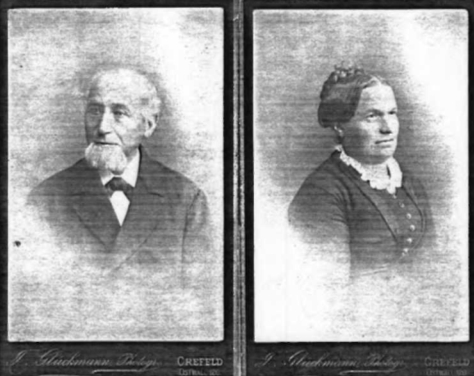 My Great Grandparents Gumpel Gompertz and Henriette Sternefeld/Gompertz
My Great Grandparents Gumpel Gompertz and Henriette Sternefeld/Gompertz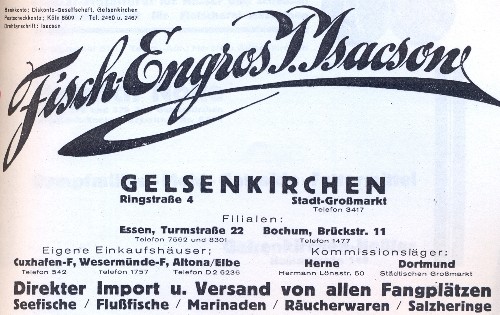 Fish Wholesale Isidor Isacson, Gelsenkirchen
Fish Wholesale Isidor Isacson, Gelsenkirchen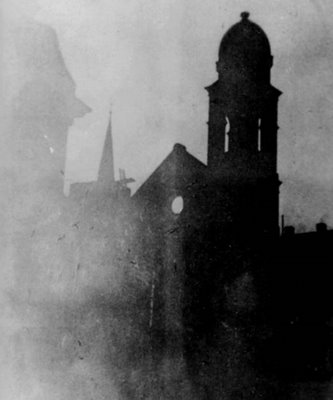 Synagogue burns in Gelsenkirchen on Nov.9/10,1938
Synagogue burns in Gelsenkirchen on Nov.9/10,1938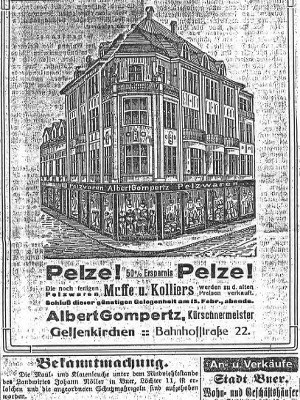
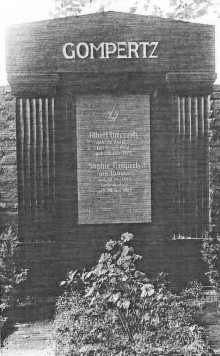 My grandparents graves in Gelsenkirchen 1934.
My grandparents graves in Gelsenkirchen 1934.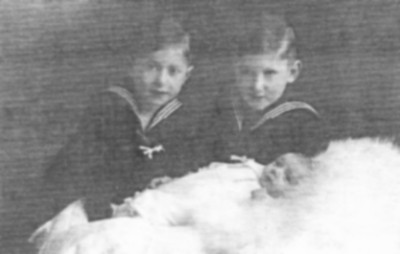 Albert, Fritz and Rolf Gompertz on January 15, 1929
Albert, Fritz and Rolf Gompertz on January 15, 1929 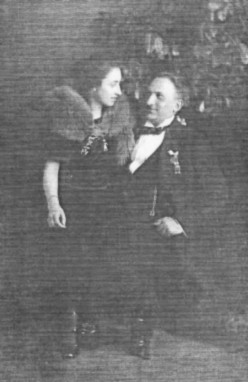 Betty and Leo Gompertz wedding in January 1921
Betty and Leo Gompertz wedding in January 1921 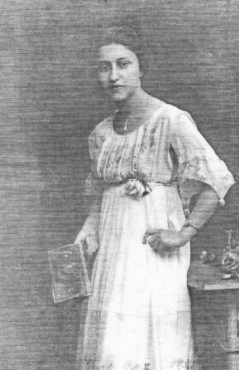 Betty Isacson, 1920
Betty Isacson, 1920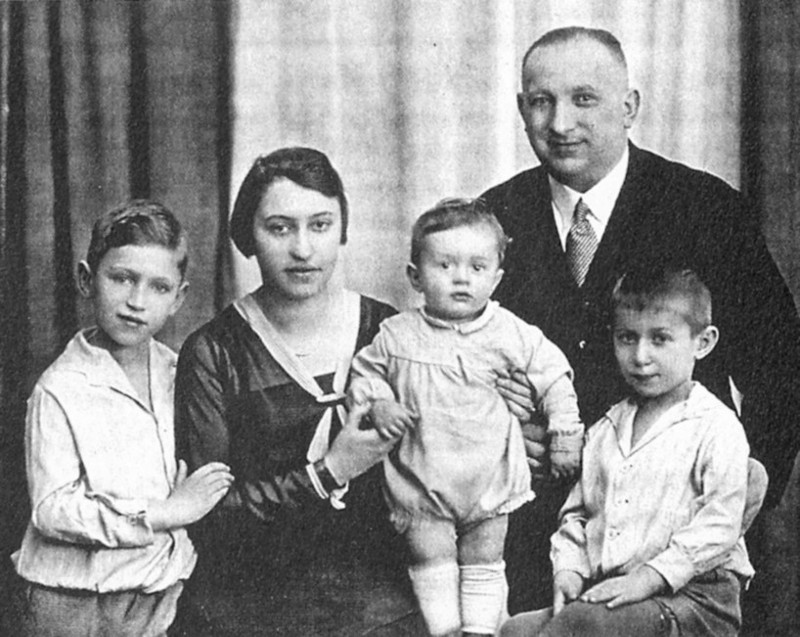
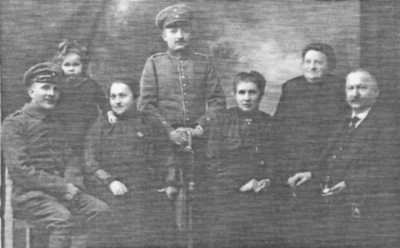 Photograph taken during the first world war, Leo Gompertz and his brother in law Josef Stamm in German Army Uniforms, in 1916. From left to right Josef Stamm, his daughter and my cousin, Ruth Stamm, my aunt Betty Stamm
Photograph taken during the first world war, Leo Gompertz and his brother in law Josef Stamm in German Army Uniforms, in 1916. From left to right Josef Stamm, his daughter and my cousin, Ruth Stamm, my aunt Betty Stamm 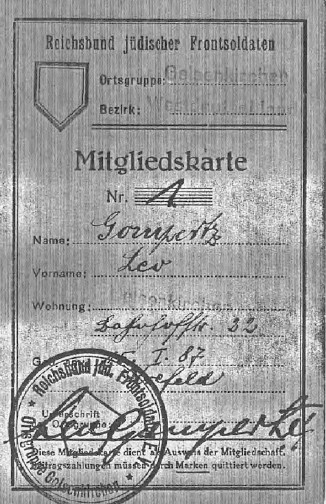 Membercard number one of the RJF for Leo Gompertz.
Membercard number one of the RJF for Leo Gompertz. 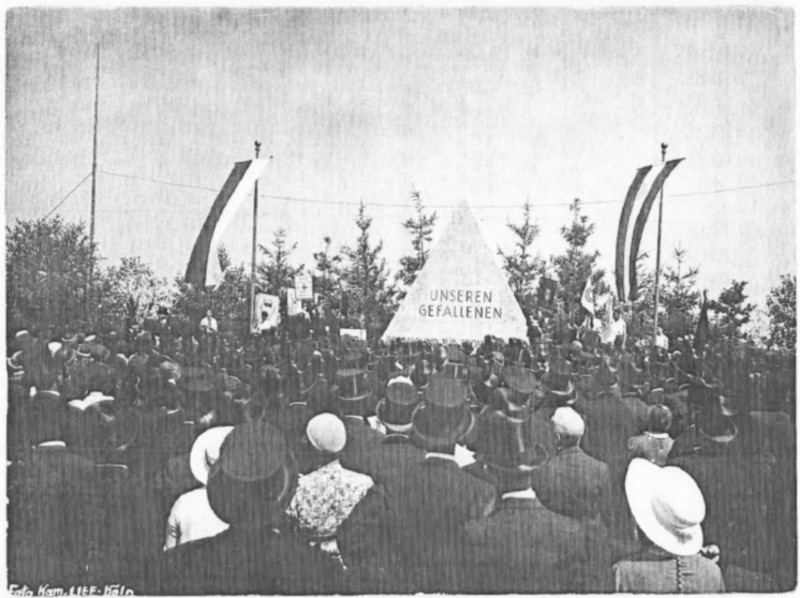
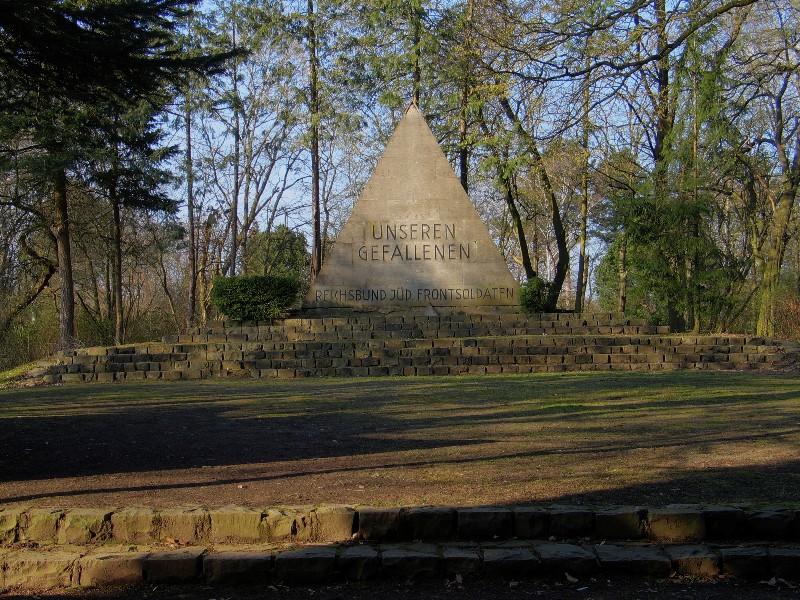
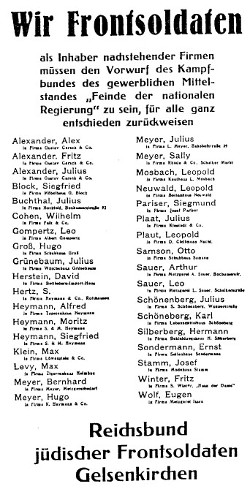 Reprint from the Gelsenkirchener Zeitung of May 5, 1933. Translation of above: We Frontsoldiers, as owners of the following listed businesses, must strongly object to the accusation by the Combat Group of the Professional Middle Class, that we are "Enemies of the National Government" signed: Former Jewish Front Soldiers, Gelsenkirchen (RJF)
Reprint from the Gelsenkirchener Zeitung of May 5, 1933. Translation of above: We Frontsoldiers, as owners of the following listed businesses, must strongly object to the accusation by the Combat Group of the Professional Middle Class, that we are "Enemies of the National Government" signed: Former Jewish Front Soldiers, Gelsenkirchen (RJF)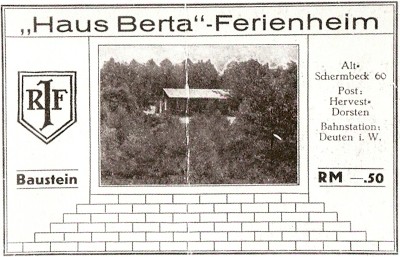
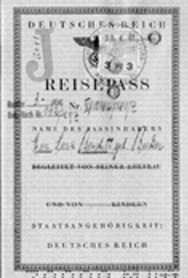
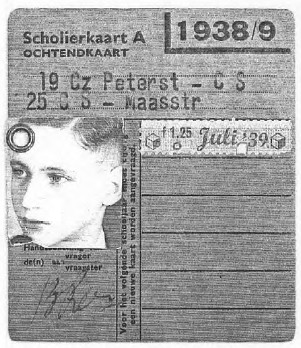 My Identification card as transient refugee in Holland.
My Identification card as transient refugee in Holland. 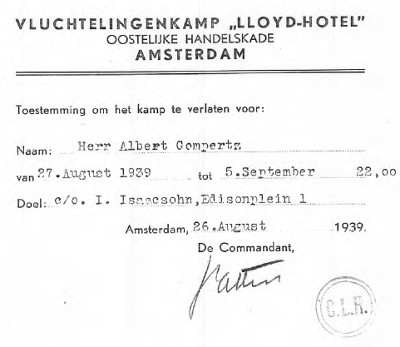 My pass to leave camp to visit my grandparents until my sailing for America on 9-3-1939.
My pass to leave camp to visit my grandparents until my sailing for America on 9-3-1939. 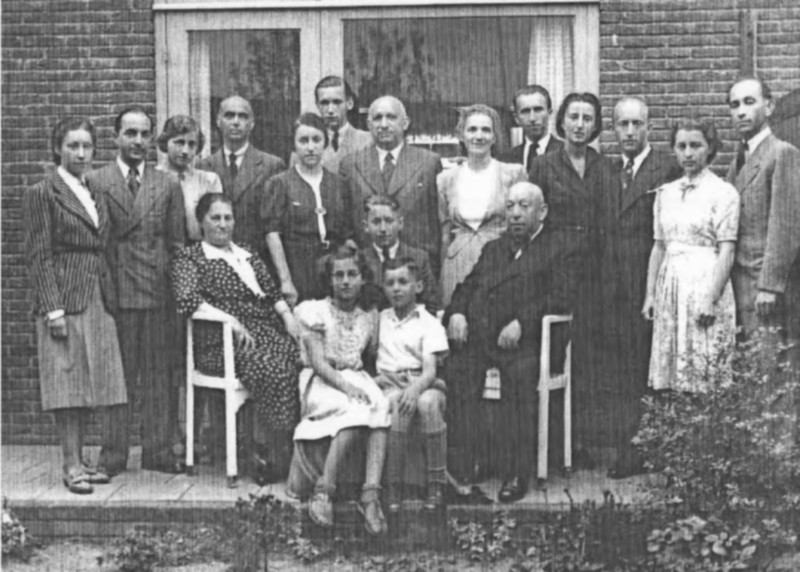
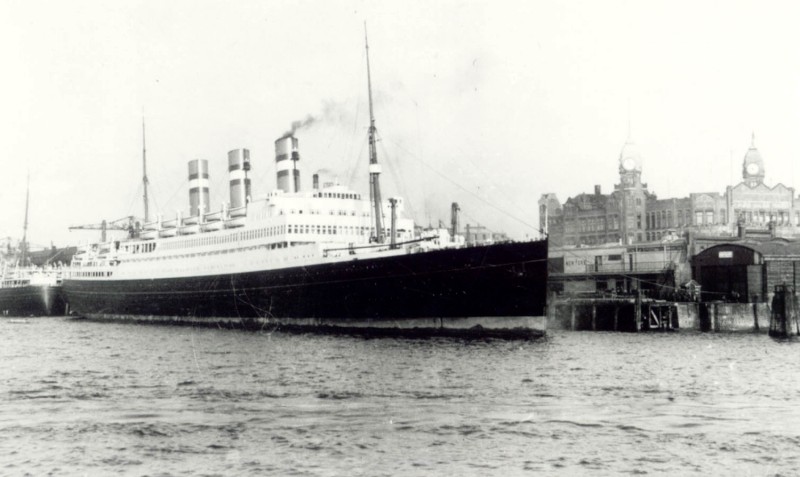
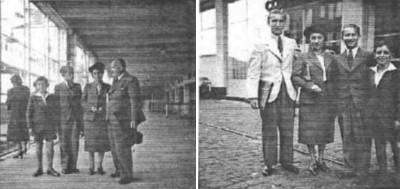 On the Holland America Line Pier in Rotterdam on September 3rd, 1939. Left Picture: Rolf, Fritz Betty and Leo. Right Picture: Albert, Betty, Fritz and Rolf.
On the Holland America Line Pier in Rotterdam on September 3rd, 1939. Left Picture: Rolf, Fritz Betty and Leo. Right Picture: Albert, Betty, Fritz and Rolf.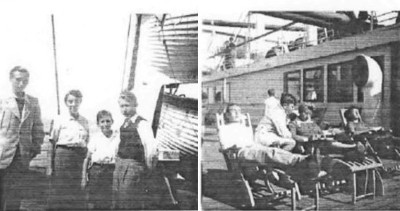 This two Photographs showing Mutti and the three boys onboard the M.S. Statendam sailing to the USA.
This two Photographs showing Mutti and the three boys onboard the M.S. Statendam sailing to the USA.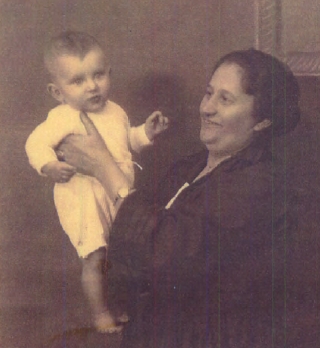 Albert and Oma Isacson in May 1922
Albert and Oma Isacson in May 1922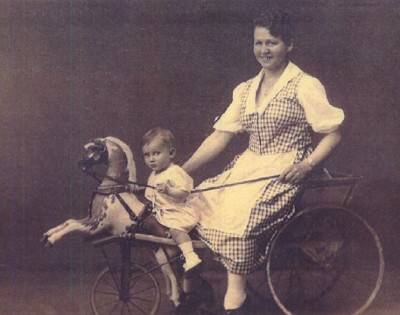 Albert and Nurse Henny Rohrbach in June 1922, 7 month old, in Bad Rothenfelde.
Albert and Nurse Henny Rohrbach in June 1922, 7 month old, in Bad Rothenfelde.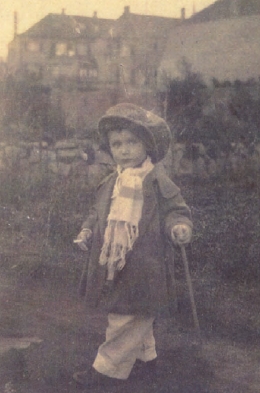 Albert dressed up as the gentleman he is in our garden at Zeppelinalle in 1926.
Albert dressed up as the gentleman he is in our garden at Zeppelinalle in 1926.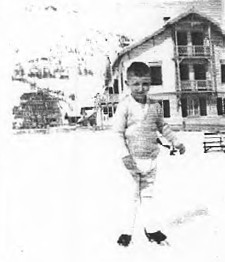
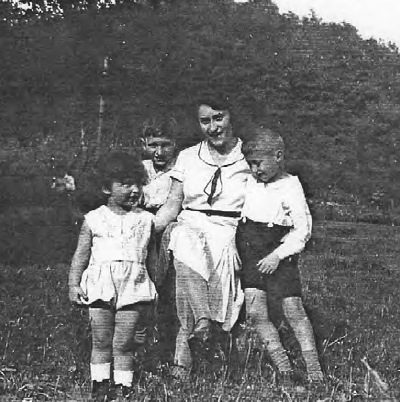 Mutti and her three boys on a picnic in 1932.
Mutti and her three boys on a picnic in 1932.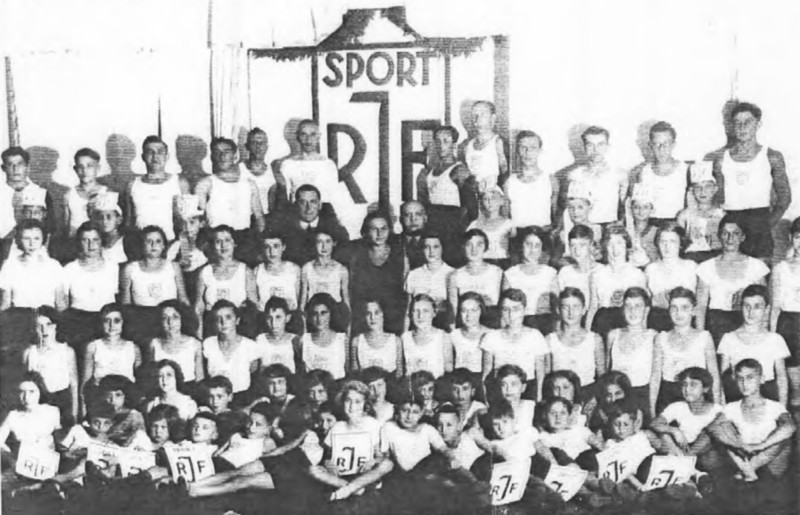

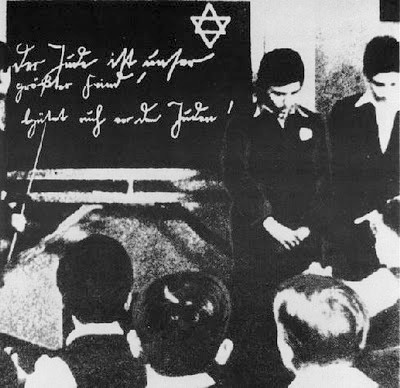 Ca. 1935: Two Jewish pupils are humiliated before their classmates. The inscription on the blackboard reads "The Jew is our greatest enemy! Beware of the Jew!" An Example of what it was like to attend the Real Gymnasium (High School) from 1932 to 1936
Ca. 1935: Two Jewish pupils are humiliated before their classmates. The inscription on the blackboard reads "The Jew is our greatest enemy! Beware of the Jew!" An Example of what it was like to attend the Real Gymnasium (High School) from 1932 to 1936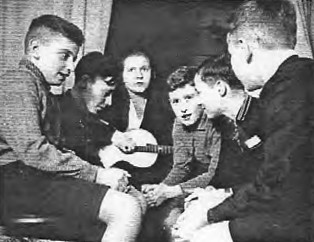 Ruth Stamm leading us in singing and handcraft as leader of "The schwarze Fähnlein" (Jewish Right Wing).
Ruth Stamm leading us in singing and handcraft as leader of "The schwarze Fähnlein" (Jewish Right Wing). 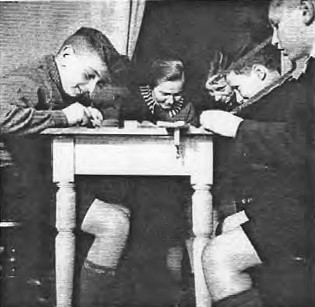 Two brothers Cohn, two brothers Alexander and Albert Gompertz in 1934
Two brothers Cohn, two brothers Alexander and Albert Gompertz in 1934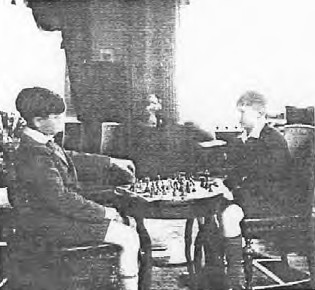 Playing chess in our living room with Heinz Löwenthal
Playing chess in our living room with Heinz Löwenthal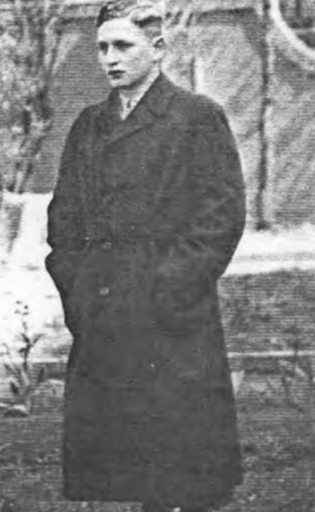 My best friend Erwin Mosbach in 1936
My best friend Erwin Mosbach in 1936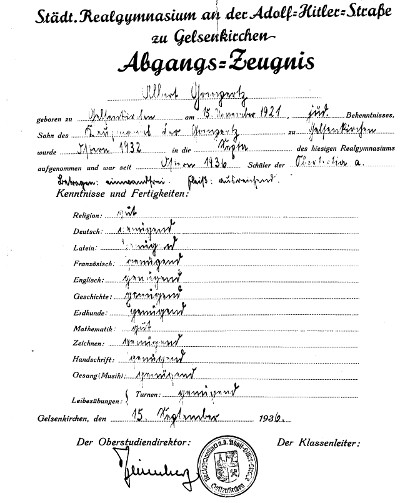 Final report card upon dismissal from Real Gymnasium in September 1936
Final report card upon dismissal from Real Gymnasium in September 1936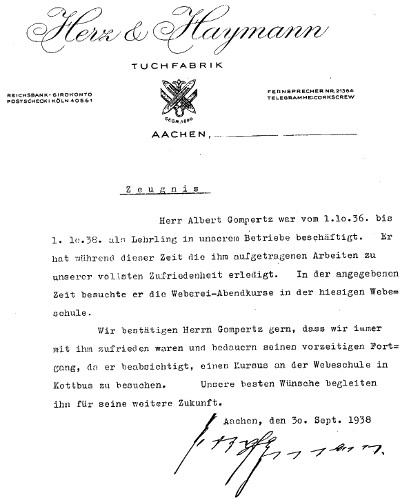 Letter from Herz&Haymann in Aachen. Reference after having served 2 years as apprentice.
Letter from Herz&Haymann in Aachen. Reference after having served 2 years as apprentice.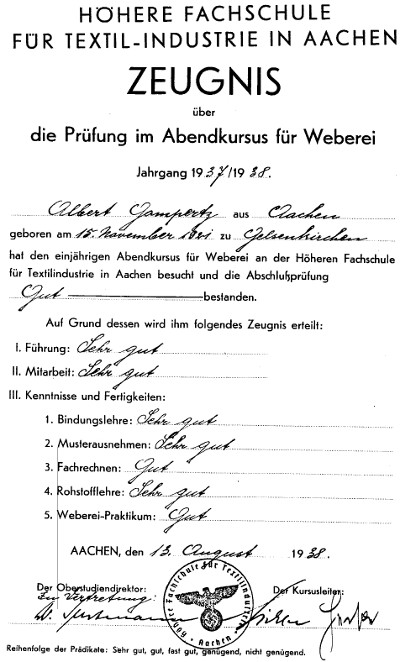 Report card from Textile College in Aachen, which i attended during my apprenticeship.
Report card from Textile College in Aachen, which i attended during my apprenticeship.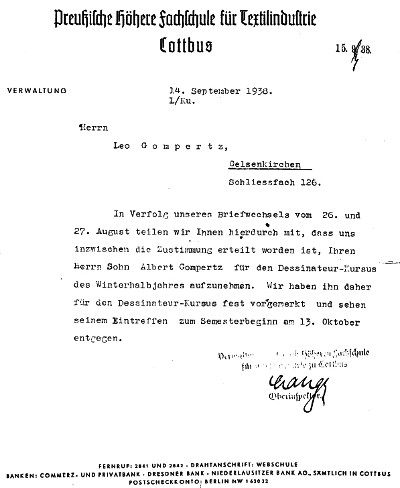 Letter of acceptance at the Cottbus Textile College for the semester starting in September 1938.
Letter of acceptance at the Cottbus Textile College for the semester starting in September 1938.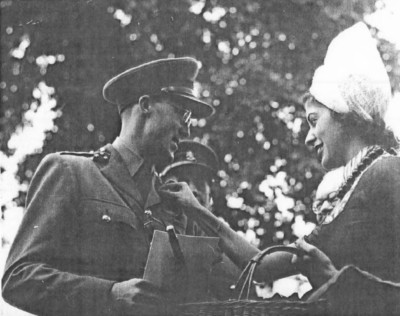 Tine Wynshenk, she married my uncle Lutz Isacson, shown presenting a medal to Prince Bernard of the Netherlands in wartime England.
Tine Wynshenk, she married my uncle Lutz Isacson, shown presenting a medal to Prince Bernard of the Netherlands in wartime England.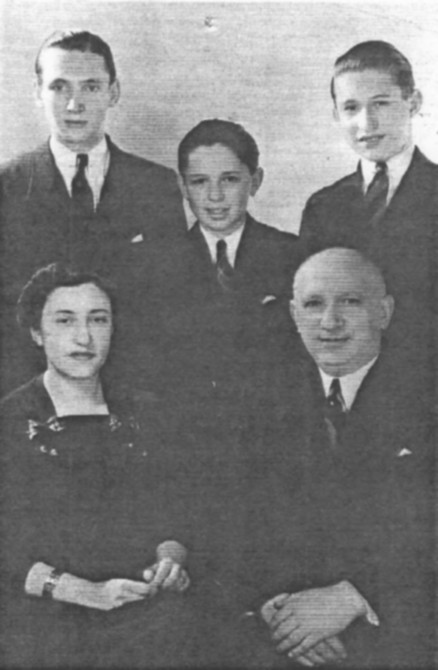 Our first Family Portrait in America, my mothers 41st birthday December 20, 1941
Our first Family Portrait in America, my mothers 41st birthday December 20, 1941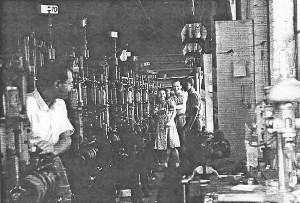 Albert and co-workers at housery knitting machines in Long Island City 1941
Albert and co-workers at housery knitting machines in Long Island City 1941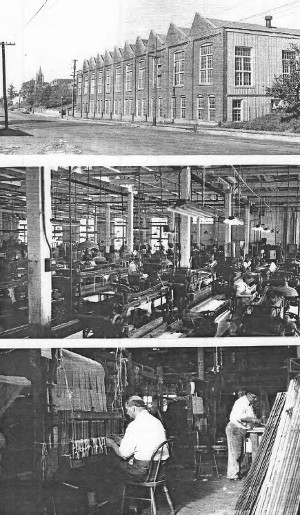 1. Outside view of St. George Textile Mill, 2. Inside Weaving hall, 3. View of Warp room
1. Outside view of St. George Textile Mill, 2. Inside Weaving hall, 3. View of Warp room 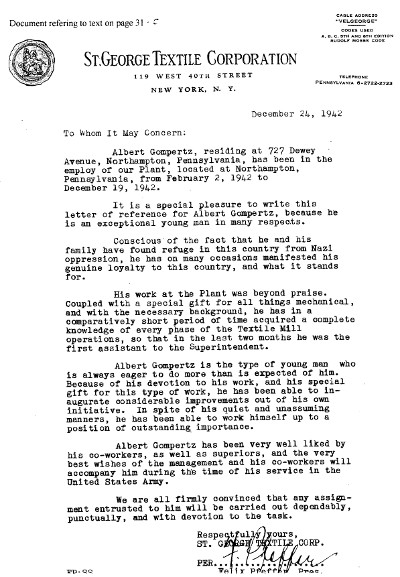 Reference from Felix Pfeffer, St. George Textile Corporation
Reference from Felix Pfeffer, St. George Textile Corporation My regular 'hangout' for Dinner in Northampton "Georgian Restaurant"
My regular 'hangout' for Dinner in Northampton "Georgian Restaurant"
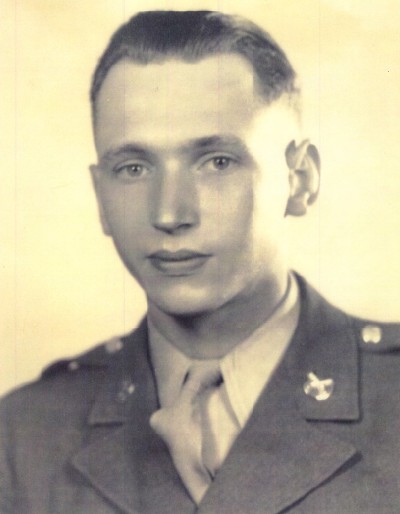 Albert Gompertz
Albert Gompertz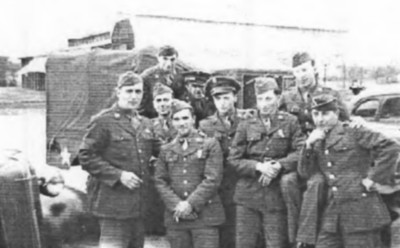 After basic training in 1943. Albert in center, 9 of us on our way to join the 441st Prisoner of War Processing Co. in Fort Custer, MI.
After basic training in 1943. Albert in center, 9 of us on our way to join the 441st Prisoner of War Processing Co. in Fort Custer, MI.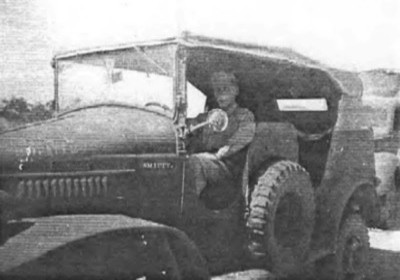 1943 in Camp Hood Texas, Albert leading a convoy
1943 in Camp Hood Texas, Albert leading a convoy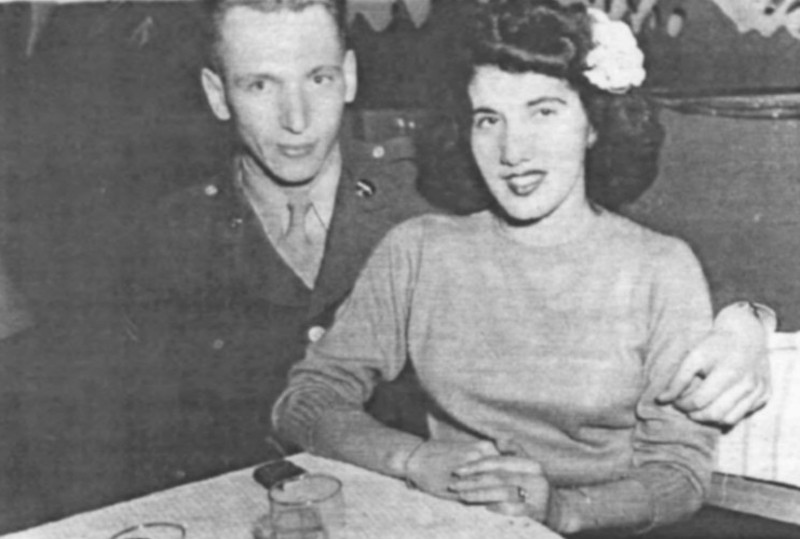
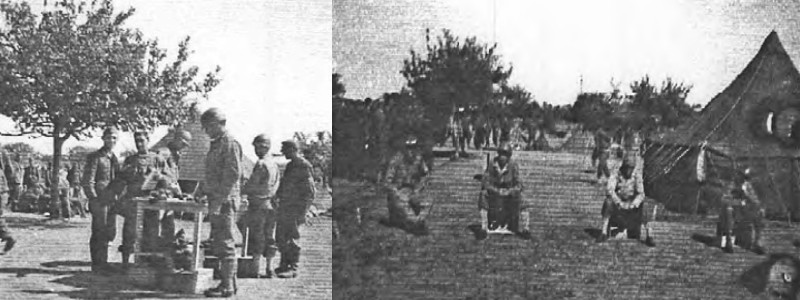
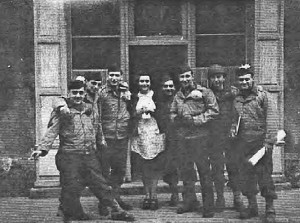 After a days of work, seven of us visiting our favorite restaurant in town for a little "drinking party". Albert on left next to owner.
After a days of work, seven of us visiting our favorite restaurant in town for a little "drinking party". Albert on left next to owner.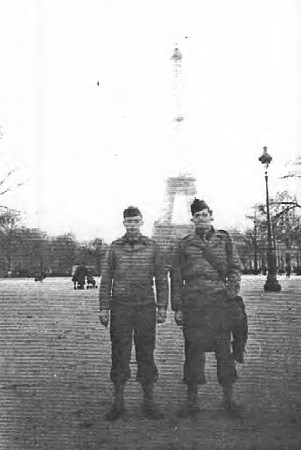 On my first pass to libarated Paris on November 25, 1944. Albert and Pvt. Veight near Eiffel Tower.
On my first pass to libarated Paris on November 25, 1944. Albert and Pvt. Veight near Eiffel Tower.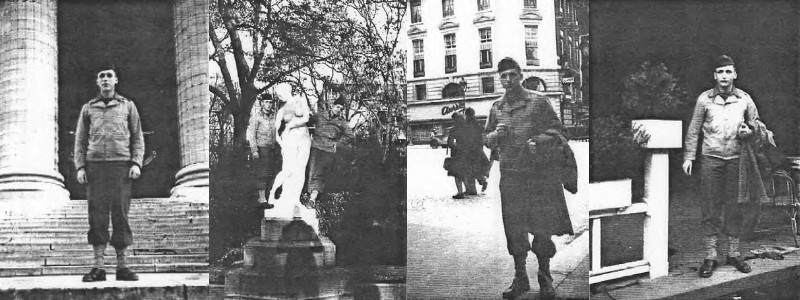
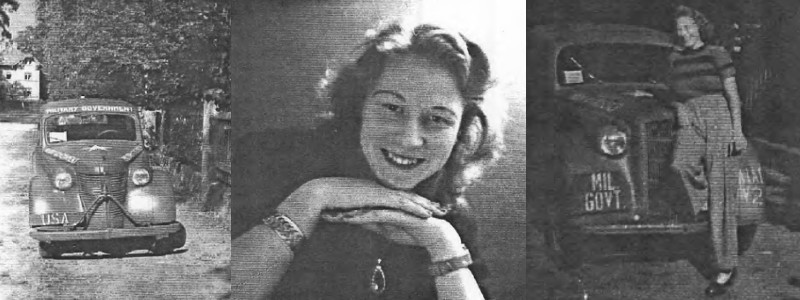
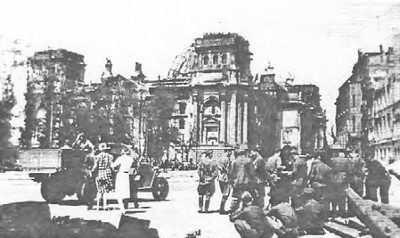 Russian soldiers in front of the destroyed "Reichstag" building.
Russian soldiers in front of the destroyed "Reichstag" building.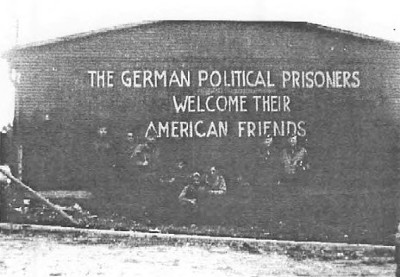
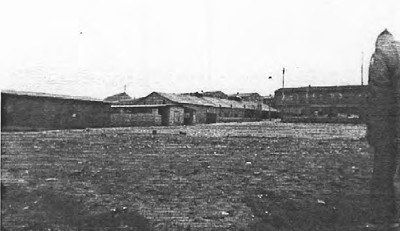 Early in June 1945 on our travel from Detmold to Eisleben we stopped in Weimar and took a side trip to Concentration Camp Buchenwald. It had been libarated on April 11 by American troops.
Early in June 1945 on our travel from Detmold to Eisleben we stopped in Weimar and took a side trip to Concentration Camp Buchenwald. It had been libarated on April 11 by American troops.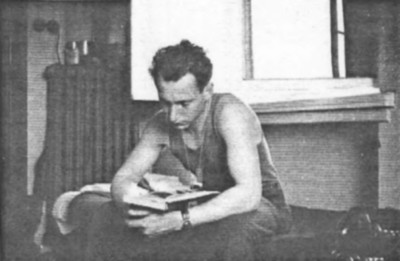 On July 1st we left Eisleben on our way to Berlin We made a stop in Halle and the photographs shows Albert on his bunk reading in our temporary quartiers.
On July 1st we left Eisleben on our way to Berlin We made a stop in Halle and the photographs shows Albert on his bunk reading in our temporary quartiers.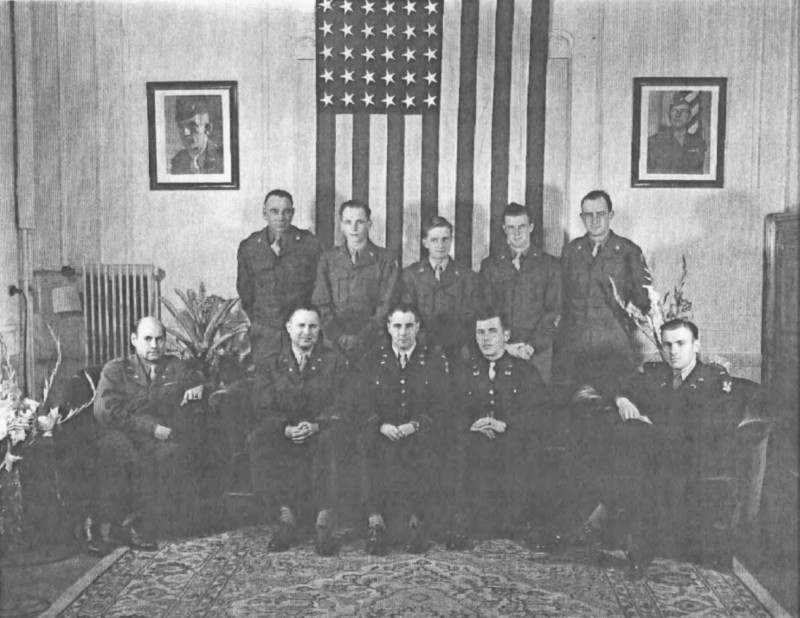
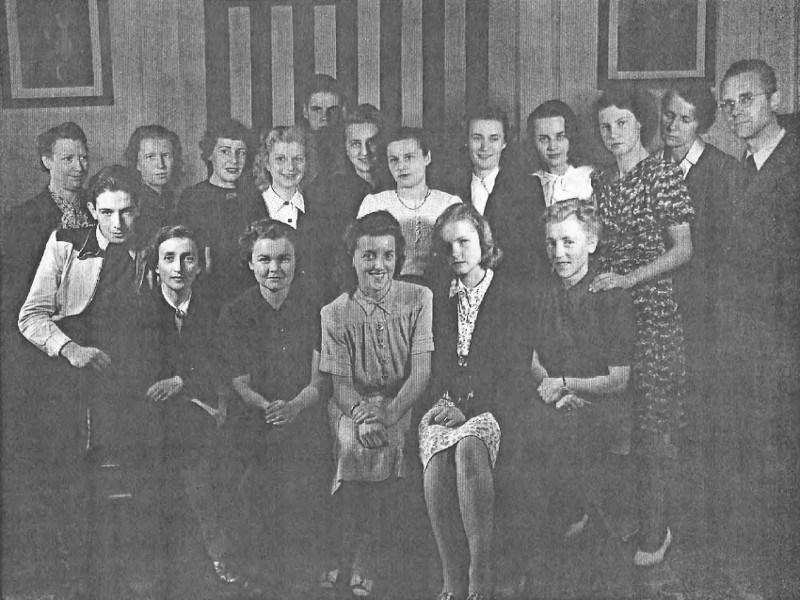
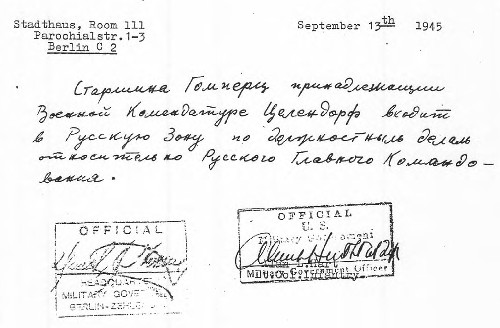
 Identification and passes to travel in all sectors of Berlin. Issued in English, French, Russian and German.
Identification and passes to travel in all sectors of Berlin. Issued in English, French, Russian and German.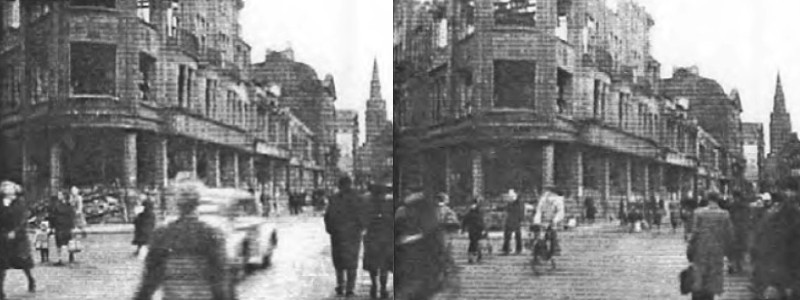
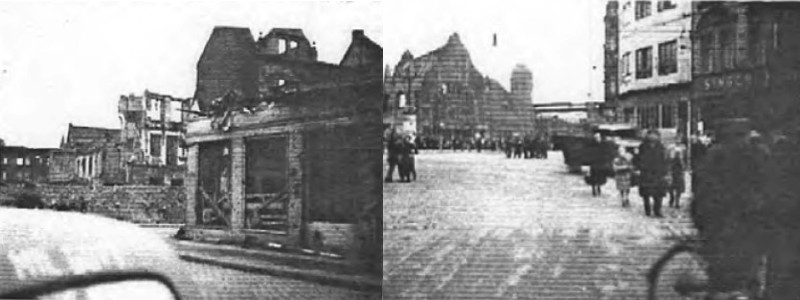
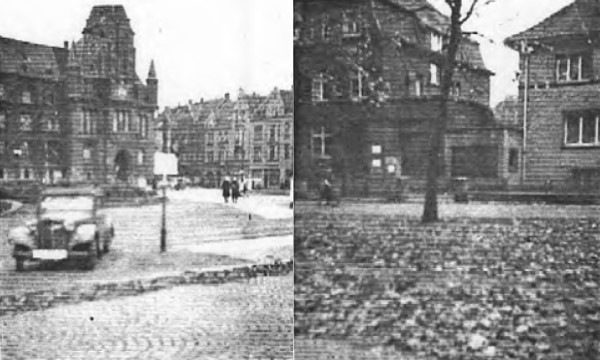
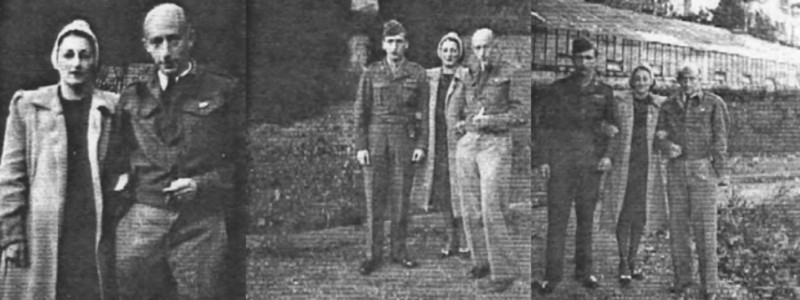
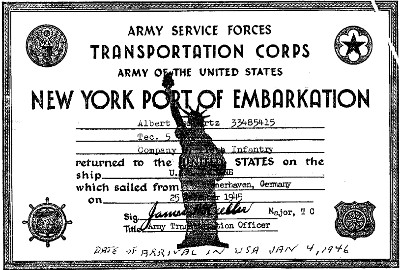 This document tells the story of my return to the United States.
This document tells the story of my return to the United States.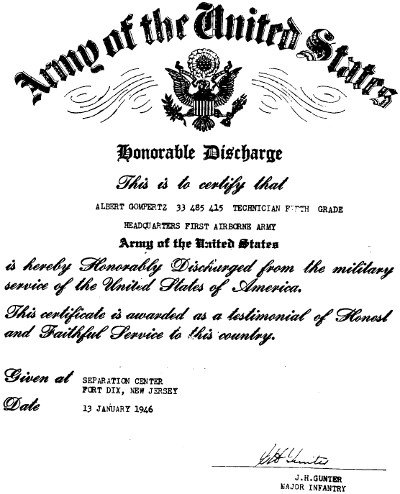
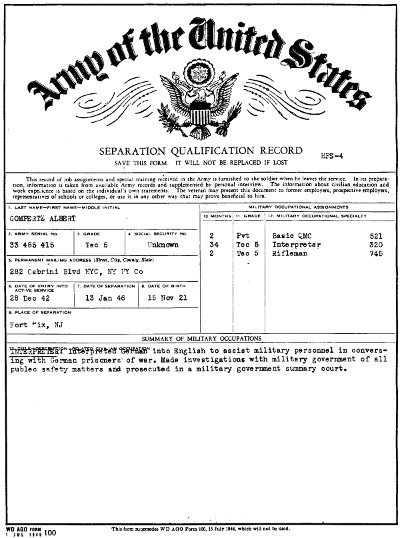
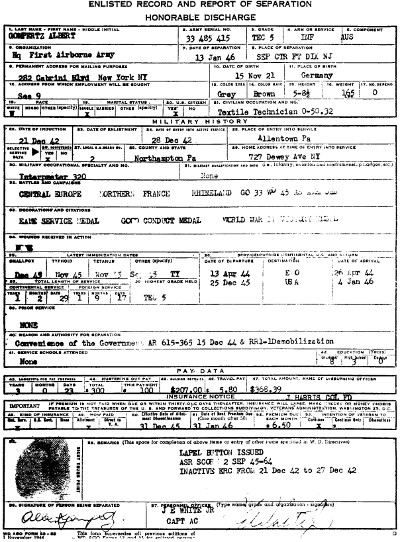 Army of the United States - Honorable Discharge
Army of the United States - Honorable Discharge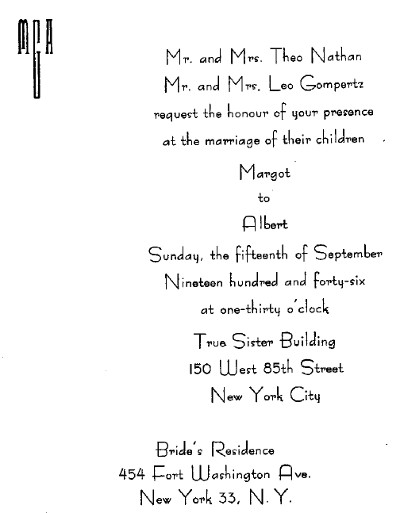 Our Wedding invitation.
Our Wedding invitation.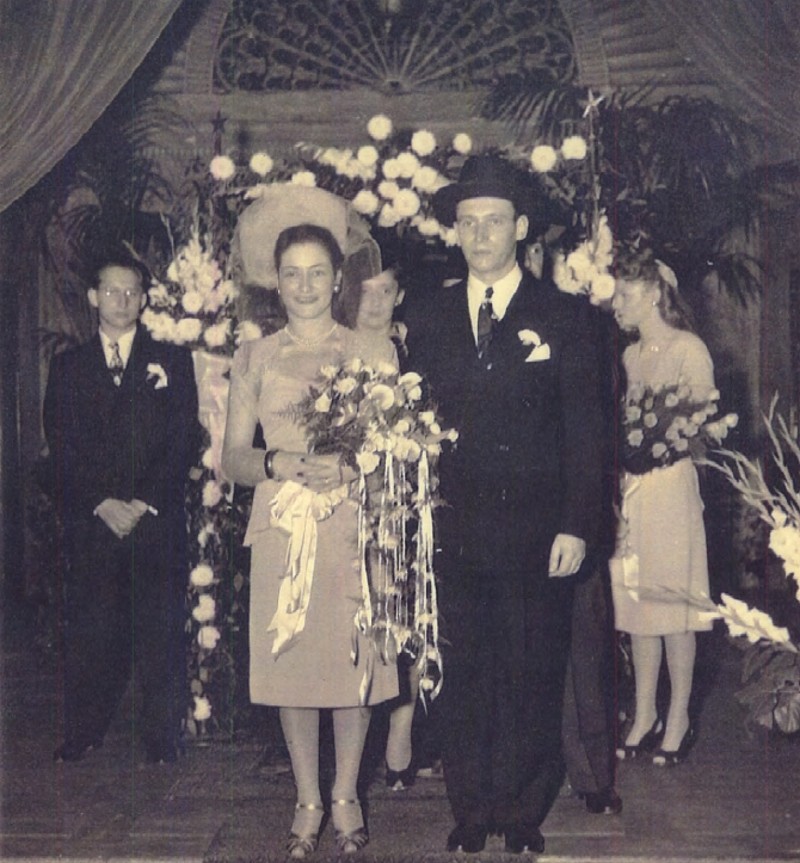
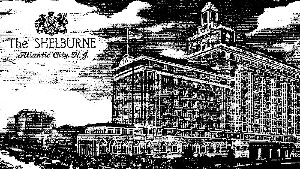 Picture of the Shelburn Hotel in Atlantic City, where we spent our honeymoon.
Picture of the Shelburn Hotel in Atlantic City, where we spent our honeymoon.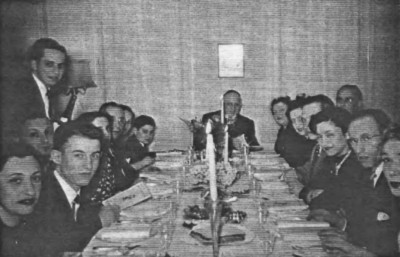 Passover 1948 at the Gompertz, left to right: Betty G., Herbert N., the Goldshmith (Cousins of Lorants) standing: Ralph, the Loranzs and son, Leo G., Betty Stamm, Herta and Theo Nathan, Albert&Margot, Marcel and Sophie Isacson.
Passover 1948 at the Gompertz, left to right: Betty G., Herbert N., the Goldshmith (Cousins of Lorants) standing: Ralph, the Loranzs and son, Leo G., Betty Stamm, Herta and Theo Nathan, Albert&Margot, Marcel and Sophie Isacson.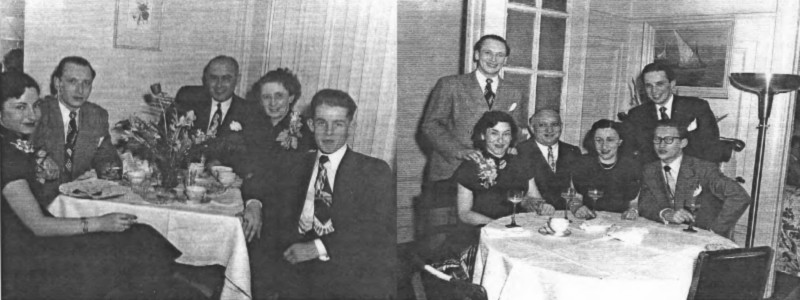
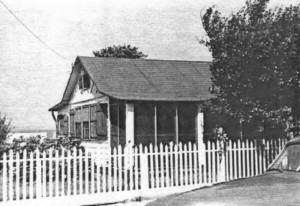 Bungalow of my parents rented in Seagate for the summer of 1948. Margot and Albert visited there, until we moved into our own place in August. (That's how it happened that Carol was born in February 1949).
Bungalow of my parents rented in Seagate for the summer of 1948. Margot and Albert visited there, until we moved into our own place in August. (That's how it happened that Carol was born in February 1949).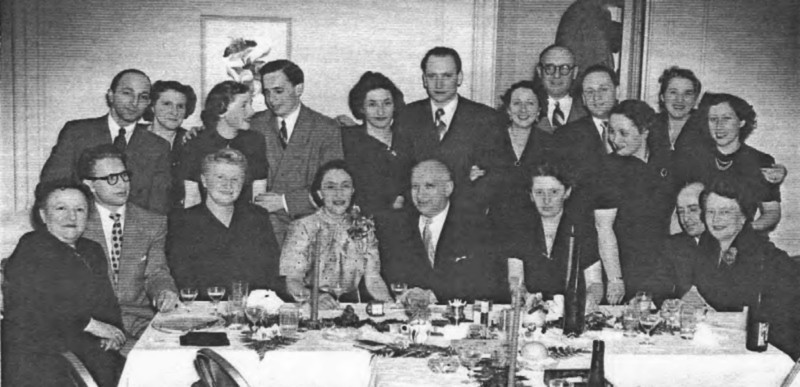
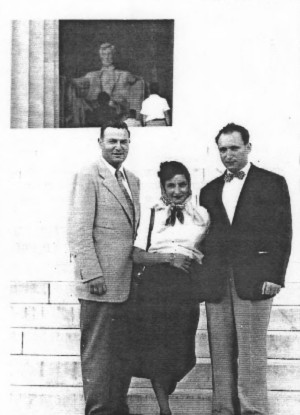 The first stop on our first vacation in 1952 in Washington D.C. in front of the Lincoln Memorial Kurt Rosenthal, Margot and Albert, Doris Rosenthal is the Photographer this time. From Washington we continued by way of the Shenandah Drive to Virginia Beach, VA.
The first stop on our first vacation in 1952 in Washington D.C. in front of the Lincoln Memorial Kurt Rosenthal, Margot and Albert, Doris Rosenthal is the Photographer this time. From Washington we continued by way of the Shenandah Drive to Virginia Beach, VA.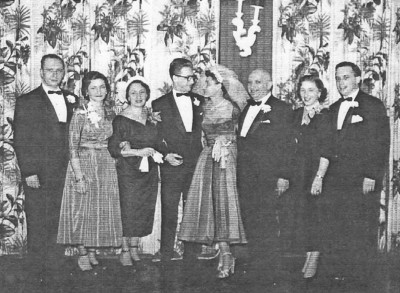 Fred and Rita's wedding. February 1st, 1953. Albert & Margot, Mother Betty, Fred & Rita, Father Leo, Ruth & Ralph.
Fred and Rita's wedding. February 1st, 1953. Albert & Margot, Mother Betty, Fred & Rita, Father Leo, Ruth & Ralph.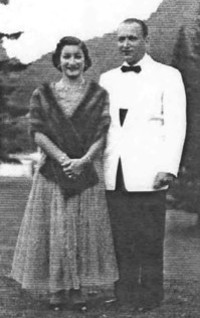 At the Balsams at Dixville Notch, N.H. in 1953. Margot & Albert all dressed up for the formal Dinner.
At the Balsams at Dixville Notch, N.H. in 1953. Margot & Albert all dressed up for the formal Dinner.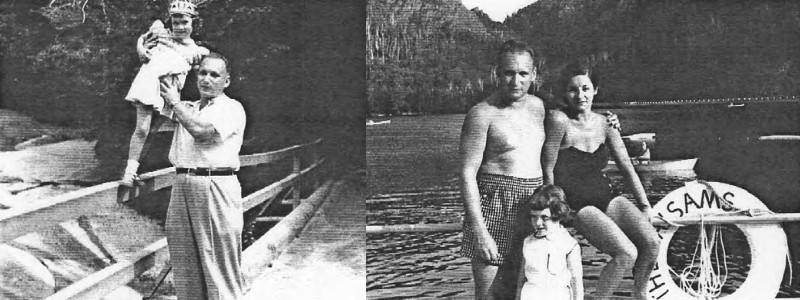
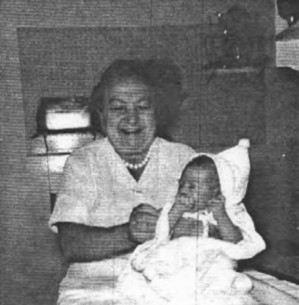 Baby Mark Alan born May 9, 1954 One week old in Flushing with his baby nurse, our aunt Betty Stamm.
Baby Mark Alan born May 9, 1954 One week old in Flushing with his baby nurse, our aunt Betty Stamm.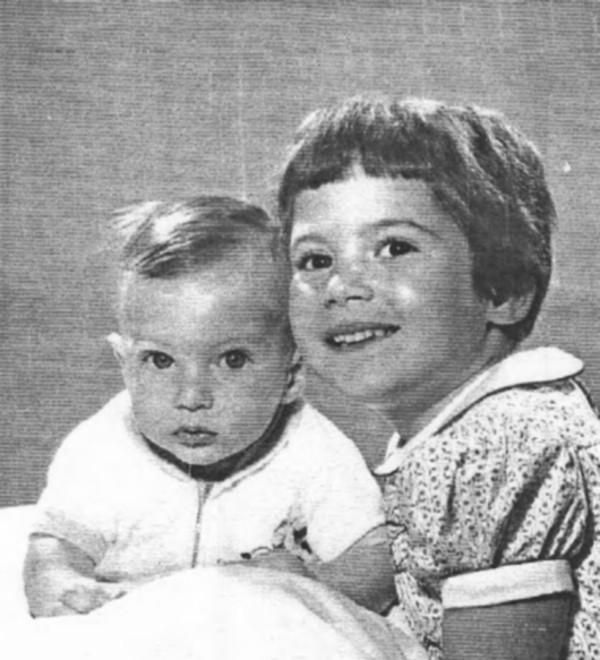
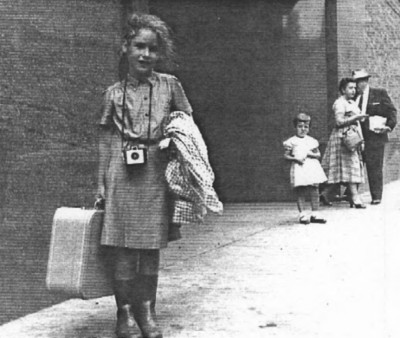 Carole returning from her first full time camping experience. Arriving at the 40th Street Bus terminal in 1956 after spending two weeks in a girl scout camp.
Carole returning from her first full time camping experience. Arriving at the 40th Street Bus terminal in 1956 after spending two weeks in a girl scout camp.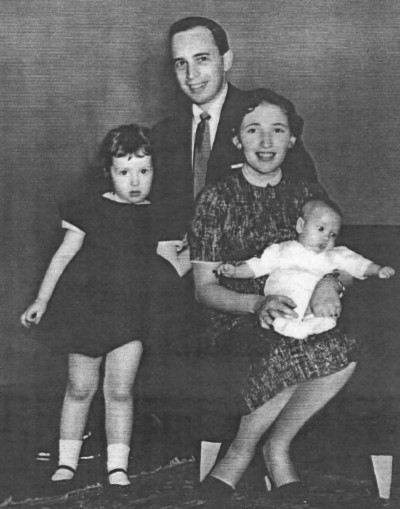 Ralph, Ruth, Sheryll, Kenneth in March 1956.
Ralph, Ruth, Sheryll, Kenneth in March 1956.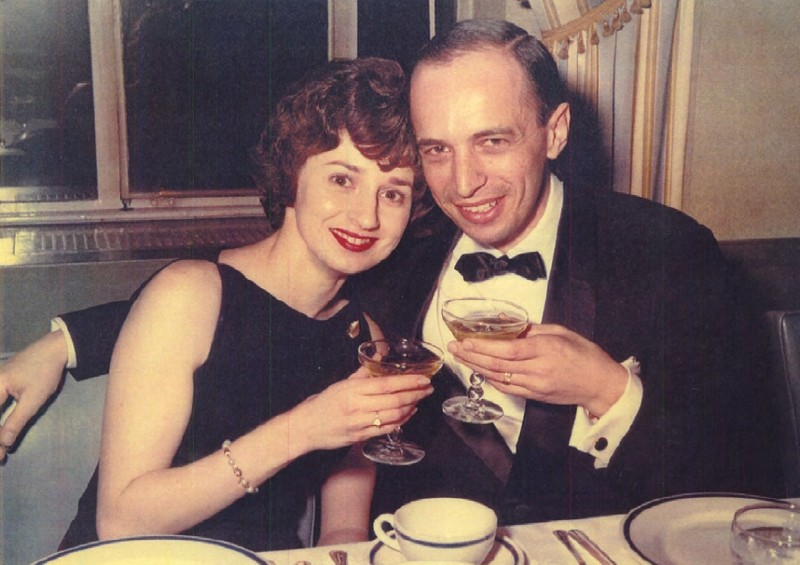
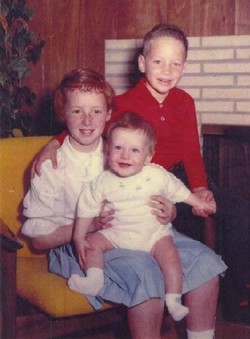 Sheryll, Kenneth and Steven in April 1962
Sheryll, Kenneth and Steven in April 1962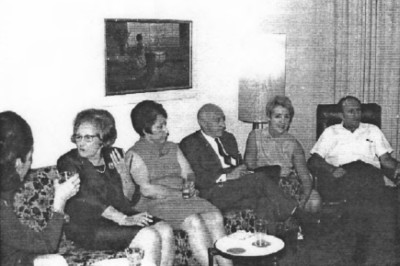 Uncle Herbert Isacson with his wife Vera on his only visit to the USA in New York in 1967 at Uncle Marcel's and his wife Claire's apartment in Forest Hills. On far left (side view: Margot with long hair) in center Aunt Fella.
Uncle Herbert Isacson with his wife Vera on his only visit to the USA in New York in 1967 at Uncle Marcel's and his wife Claire's apartment in Forest Hills. On far left (side view: Margot with long hair) in center Aunt Fella.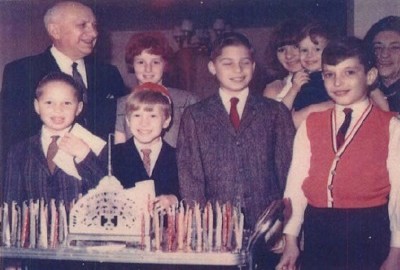 Chanukah candle lightning at Opa & Omi's house in 1963. Kenneth, Jeffrey, Ron,Mark, in back row: Opa, Sheryll, Carole, Steven & Omi.
Chanukah candle lightning at Opa & Omi's house in 1963. Kenneth, Jeffrey, Ron,Mark, in back row: Opa, Sheryll, Carole, Steven & Omi.